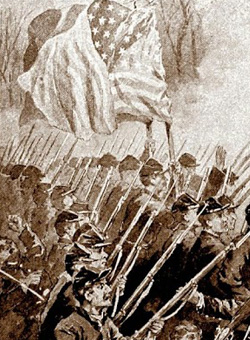
Please send all Checks and Money orders to :
Dave Taylor P.O. Box 87 Sylvania, OH 43560
419-842-1863
Click Here to E-mail Us!

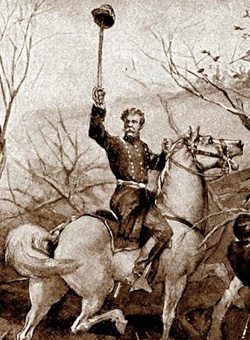
16-02-01
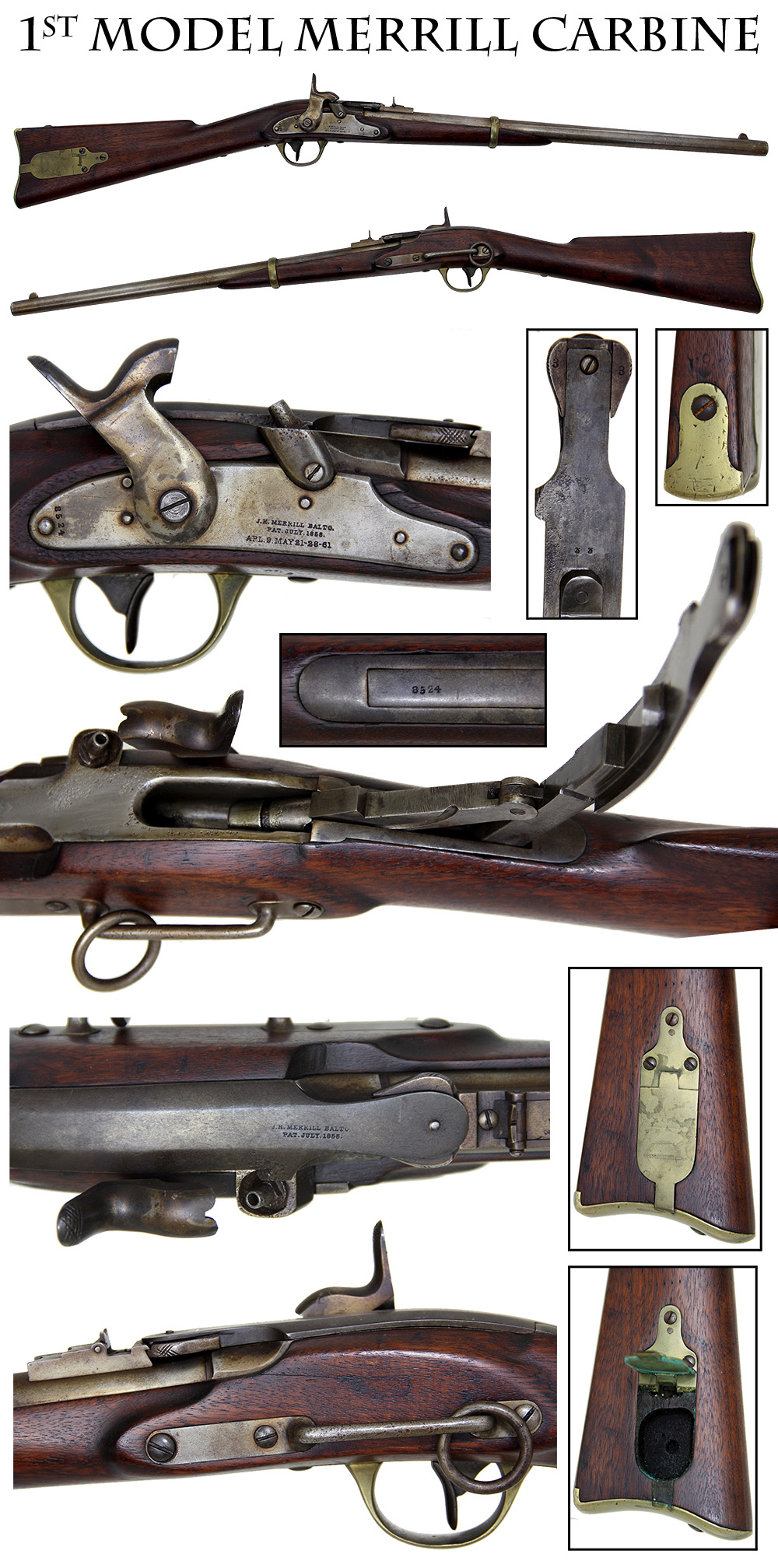
16-02-01 … 1st MODEL MERRILL CARBINE … These Baltimore carbines have always been highly sought as they saw heavy service before and during the Civil War in the hands of both Union and Confederate troopers. I once owned an example inscribed on the patch box to a pre war trooper named Rector in Ashby’s Virginia Cavalry. This standard First Model is in NRA “very good ” condition. It bears matching serial numbers 8524, and has batch numbers of 33 on smaller internal parts. This is the early war production Merrill with the brass patch box and flat lever release ears. Initials “DP” are neatly incised on the patch box, likely the soldier’s.. It is 100% original and complete with no repairs and no replaced parts. The wood is near fine with strong edges and honest light wear, There is a faint inspector’s cartouche visible in the stock opposite the lock. There is a tiny stress hairline forward of the cartouche, otherwise the wood is fine. Bore is excellent. Mechanically perfect. If you have been looking for an honest patchbox-style Merrill in better than average condition, you will be well pleased with this carbine.
Ae/allis … $2,150.00 – SOLD
Call us @ 419-842-1863
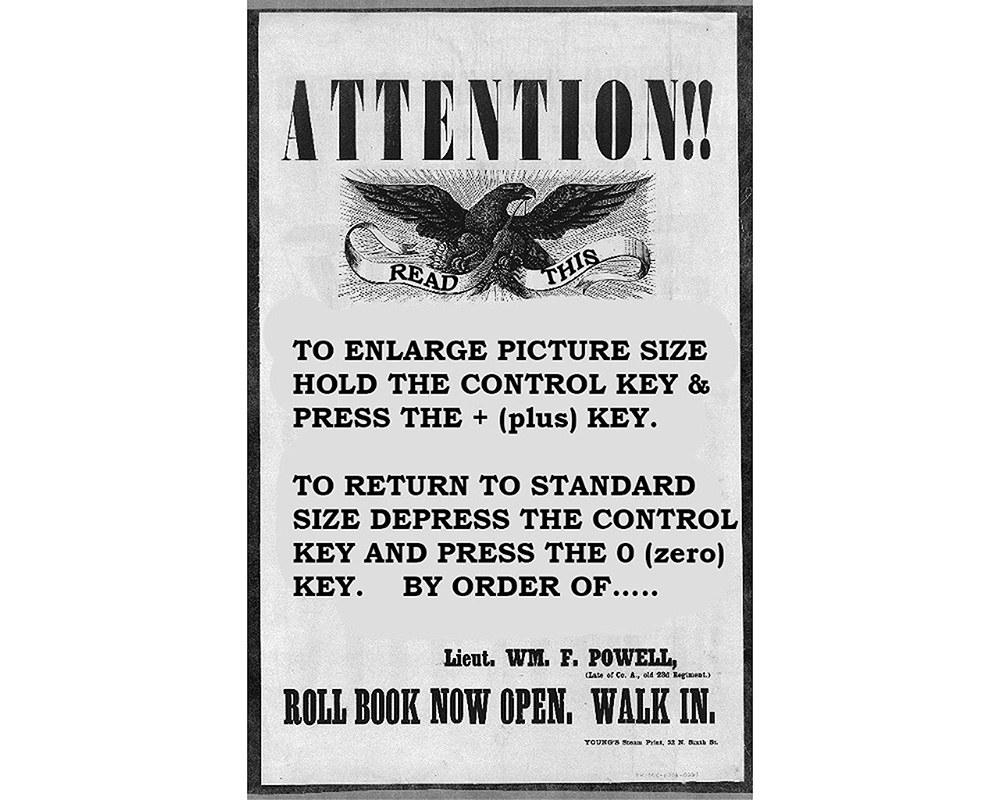
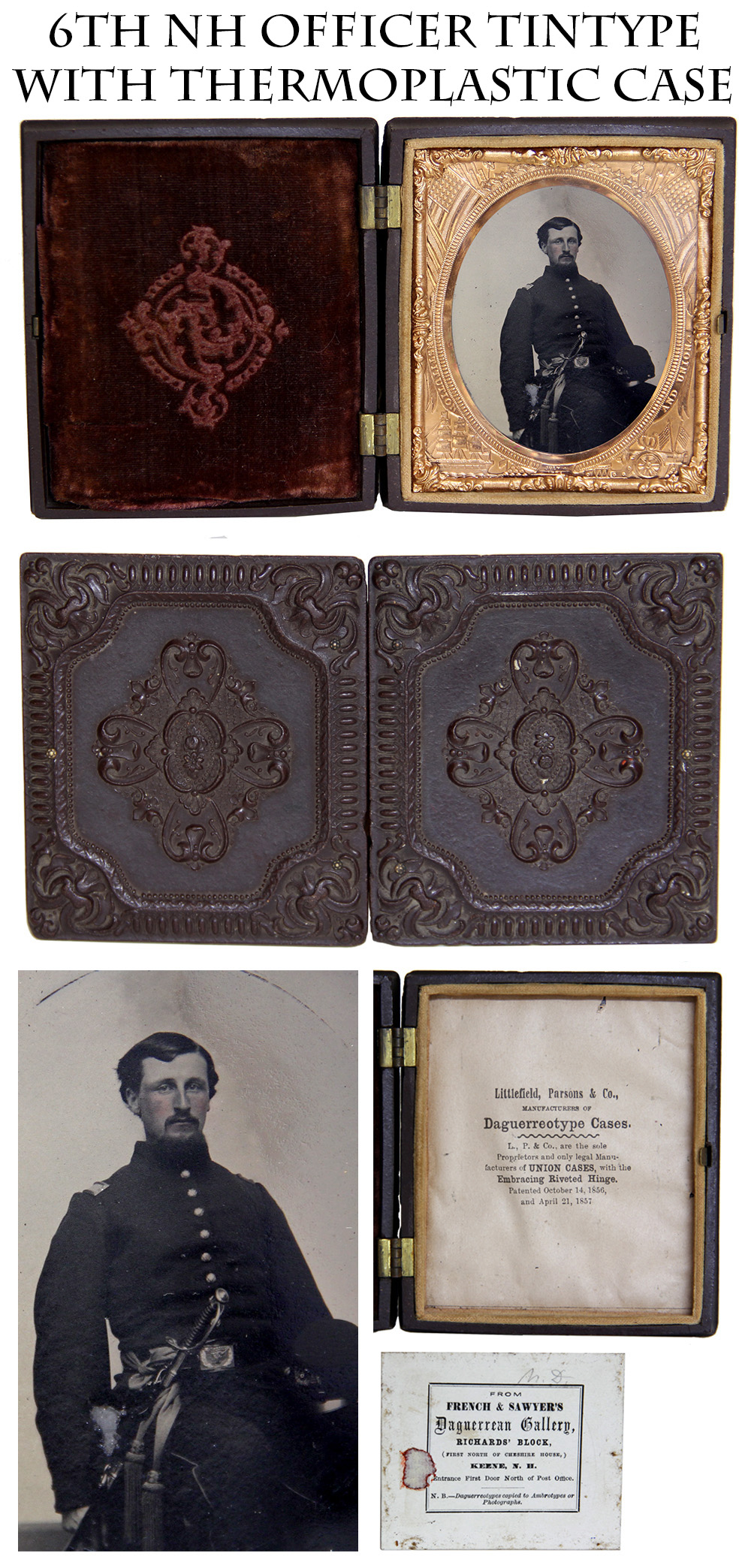
16-02-02 … ARMED 6th NEW HAMPSHIRE OFFICER TINTYPE … Ultra Crisp and Clear sixth plate tintype of an infantry second lieutenant in his regulation frock coat with shoulder straps, officer’s sash and sword belt. At his side is his 1850 foot officer’s sword and he holds his forage cap showing a prominent infantry officer’s hunting horn insignia with a numeral “6” inside the loop on the horn. The officer’s cheeks have been delicately tinted and the clarity of the image is wonderful. There is a small scuff on the officer’s sleeve, otherwise about mint. The image is cased in a Littlefield, Parsons and Company Union case with floral motifs and just a few tiny edge bumps. On the back of the tintype is a label from “French and Sawyer’s Daguerrean Gallery” of Keene, New Hampshire. The Sixth New Hampshire, which fought in the 9th Corps, organized in Keene. Here is a list of their engagements …
Camden, N.C. … … … …. … …….. … … … … … … Apr. 19, 1862
Bull Run, Va. … … … …….. … .. . … … … … … … . Aug. 29, 30, 1862
Chantilly, Va. … … … … … …. … ….. .. … … … … . Sept. 1, 1862
South Mountain, Md. ….. … ….. . … …. … … … …. Sept. 14, 1862
Antietam, Md. … … … … ….. … ……. … … … … ….Sept. 17, 1862
White Sulphur Springs, Va. …… … ….. …. … … … .Nov. 15, 1862
Fredericksburg, Va. … … … ….. … ….. . … … … … Dec. 13, 1862
Siege of Vicksburg, Miss. … … … ….. … … … … … June 14 to July 4, 1863
Jackson, Miss. … … … … …. … ….. .. … … … … … July 10-16, 1863
Wilderness, Va. … … … … … ….. … ……. … … … ..May 6, 1864
Spottsylvania, Va. … … … … … ….. … ….. . … … …May 8-20, 1864
North Anna River, Va. … …. … ……… … .. … … … May 23-26, 1864
Totopotomoy, Va. … … …. … …. … …….. … … … .May 30,31, 1864
Bethesda Church, Va. … …. … …. … …….. … … … June 2,3, 1864
Cold Harbor, Va. … … … …. … …. … ….. … … … ..June 4-12, 1864
Siege of Petersburg, Va., … ….. … … … … … ….. …June 16, 1864 to Apr 3, 1865
Mine Explosion, Petersburg, Va. (assault) …. … …. July 30, 1864
Weldon Railroad, Va. … … …… … .. … … … … … .Aug. 20-22, 1864
Poplar Springs Church, Va. … …… … .. … … … … Sept. 30, Oct. 1, 1864
Hatcher’s Run, Va. … … … … … … ….. … … … … .Oct. 27, 1864
Petersburg, Va. … … … … … … … … … … … … … Apr. 1, 2, 1865
A fine historical Civil War image … cjj … $495.00
Call us @ 419-842-1863
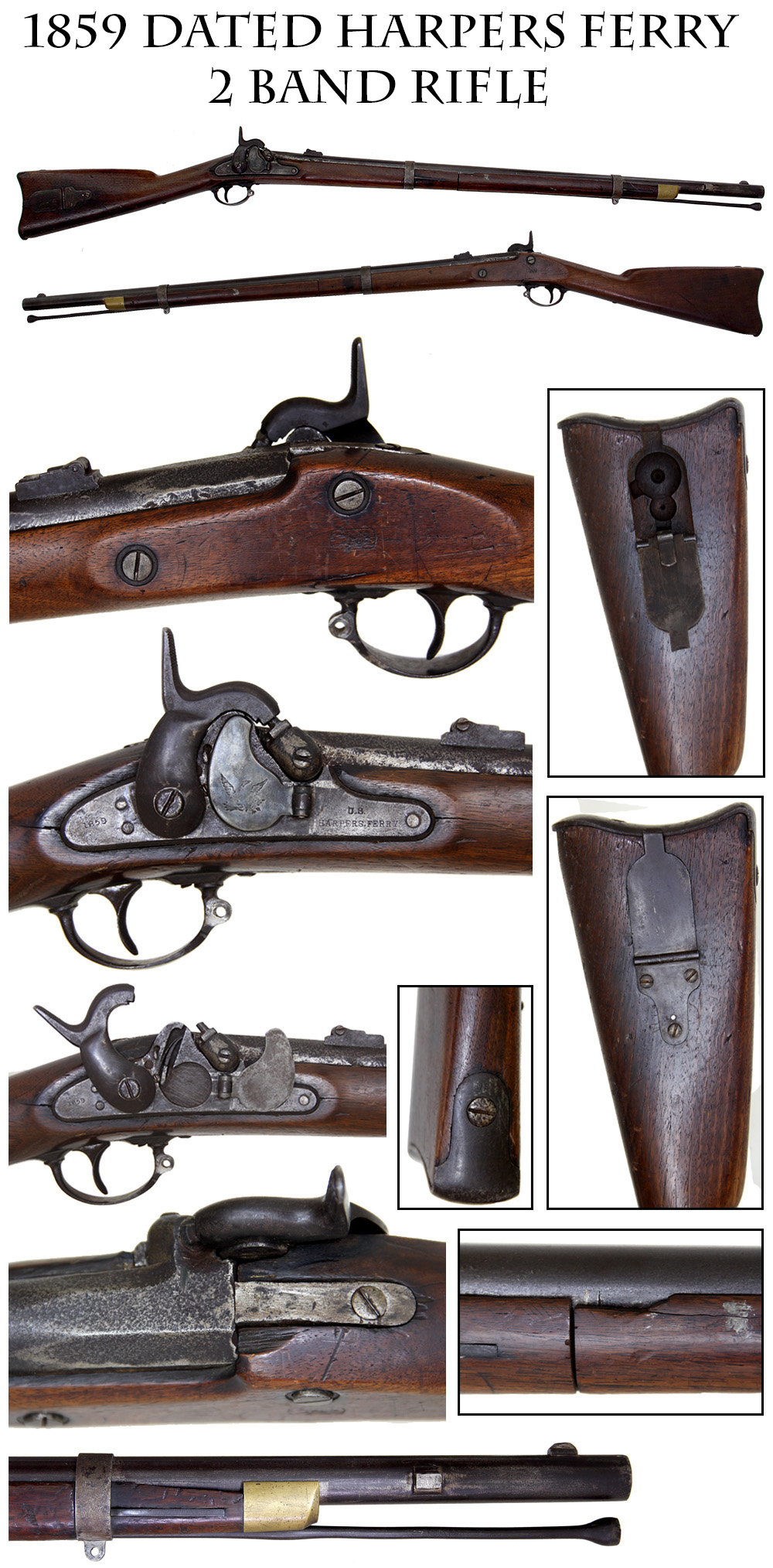
16-02-03 … EXCEEDINGLY SCARCE HARPER’S FERRY 1855 RIFLE … One of the holy grails of American Martial Arms. A Type-II 1855 2-band Harpers Ferry .58 caliber rifle with short range1858 pattern rear sight authorized in early 1859, and iron barrel bands introduced in 1859. This is an early type-II rifle, retaining the type-I brass nose cap that was used until the second half of that year. The 1859 lock date is clearly visible, as is US over Harpers Ferry forward of the hammer. When we found this it was missing the primer door and rear sight … and the primer door retaining button was a blacksmith repair. We corrected the door and sight and left the button as found. The primer door is a proper new-made replacement that helper Chuck installed. It has the proper Harpers Ferry style eagle. The door opens easily and the tape feeding mechanism works. The primer door retaining button was repaired years ago using a bent piece of steel rod. Bayonet lug is in place at the muzzle and the ultra rare correct 1855 rifle ram rod is still present. The lug was cobbled on long ago, but still intact. Both sling swivels need to be replaced. The butt plate and patchbox are good. The patchbox shows the early style inletting for the detachable figure 8 sharpshooter’s front sight. According to Moller 650 of these rifles were made in 1859 and he comments that the 1858 pattern sights were retrofitted to them, brass nose caps and figure 8 inletting in the patch box were standard in early 1859. The rear sight was missing when we got this and I had helper Chuck install an original sight that I had put away years ago just in case a worthy patient ever showed up needing this remedy. The metal surfaces overall are fairly smooth toward the muzzle but does have pitting as it nears the breech. This is definitely a gun that saw some action. The wood shows wartime handling wear. It retains a cartouche on the offside. There is a short crack fore and aft of the lock, and some chipping around the breech plug. The saddest aspect of the gun is that the forend has been neatly sawed in two between the barrel bands. On WW-2 rifles these cuts are known as duffle-cuts. Rifles shortened to fit in a duffle bag for the long boat trip home. During the first half of the 20th century when postage was expensive and old guns were virtually worthless it was a frugal gun trader who saved a little money by cutting a long stock in half and shipping a rifle or musket in a shorter box. Sad but true. Most of these 1855 rifles wound up going south when the Rebs captured the arsenal at Harpers Ferry. This is a very scarce gun priced right for the handful of little “warts”. The original ramrod is a heck of a find … $2,450.00 – SOLD
Call us @ 419-842-1863

16-02-04 … BRITISH OFFICER’S SABER 1830-1837 UNDER KING WILLIAM IV … British officer’s saber of the 1822/23 pattern with a beautiful bright-etched blade bearing the cipher of William IV, who ruled Britain from 1830 to 1837. Excellent edge and point, blade bright with just some graying. Iron hilt with an intact sharkskin grip with wire binding. The original white buff leather sword knot is in place on the hilt as well. The scabbard has both rings, the drag, and the throat in place. Finished in the bright, it now is silvery gray with some brown areas coming up. This is an impressive officer’s sword that was the pattern for many imports used by American Civil War officers some twenty-five or thirty years later. Nicely etched by the retailer at the ricasso: “W. Moore/ Late / Bicknells / & Moore / 1/ Old Bond St./ London.” A classy sidearm with a darn scarce knot. The knot is easily worth $250 by itself. Priced like a common old import Civil War saber… but this sword is high quality and a real gem … bjj-mil … $595.00 – SOLD
Call us @ 419-842-1863
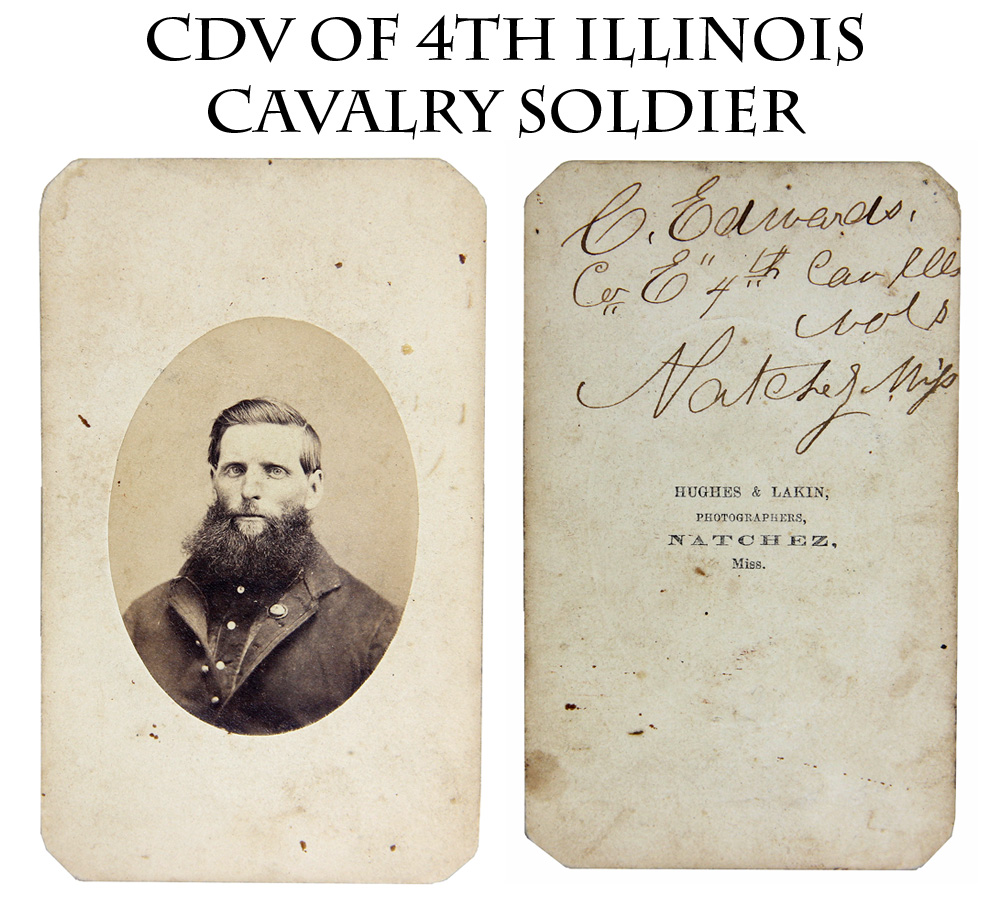
16-02-05 … CORNELIUS EDWARDS COMPANY E 4th ILLINOIS CAVALRY … Clear cdv mounted oval albumen portrait of a bearded soldier with his shell jacket thrown open to reveal a brooch or cameo pinned to his inner lapel. Nicely signed in ink on the reverse of the card: “C. Edwards / Co. E 4th Cav Ills / Vols/ Natchez Miss.” Cornelius Edwards resided in Charleston, Ohio, but enlisted on 9/6/61 in the 4th Illinois cavalry and mustered in a private in Co. E on 9/26/61. The regiment saw its first active service as the advance guard in a reconnaissance to Columbia, Kentucky, in December, 1861. It served for the most part in Tennessee and Mississippi, losing one officer and thirty-one enlisted men killed or mortally wounded. It was involved in the attacks on Fort Henry and Fort Donelson, and later at the battle of Shiloh and the advance on Corinth, many of its casualties falling in small engagements that cavalry tended to find themselves involved in on an active campaign. In the Fall of 1863 it was ordered to Vicksburg and served there until mustered out. Edwards was one of the men who did not reenlist and mustered out 11/3/64. The card corners were trimmed slightly for album insertion and the card bears a Hughes and Larkin, Natchez, photographer’s backmark. A very scarce photographer’s imprint. Given the prominence of the pin in the photo, Edwards probably intended to diplay it as a memento and message to someone … $125.00 – SOLD
Call us @ 419-842-1863
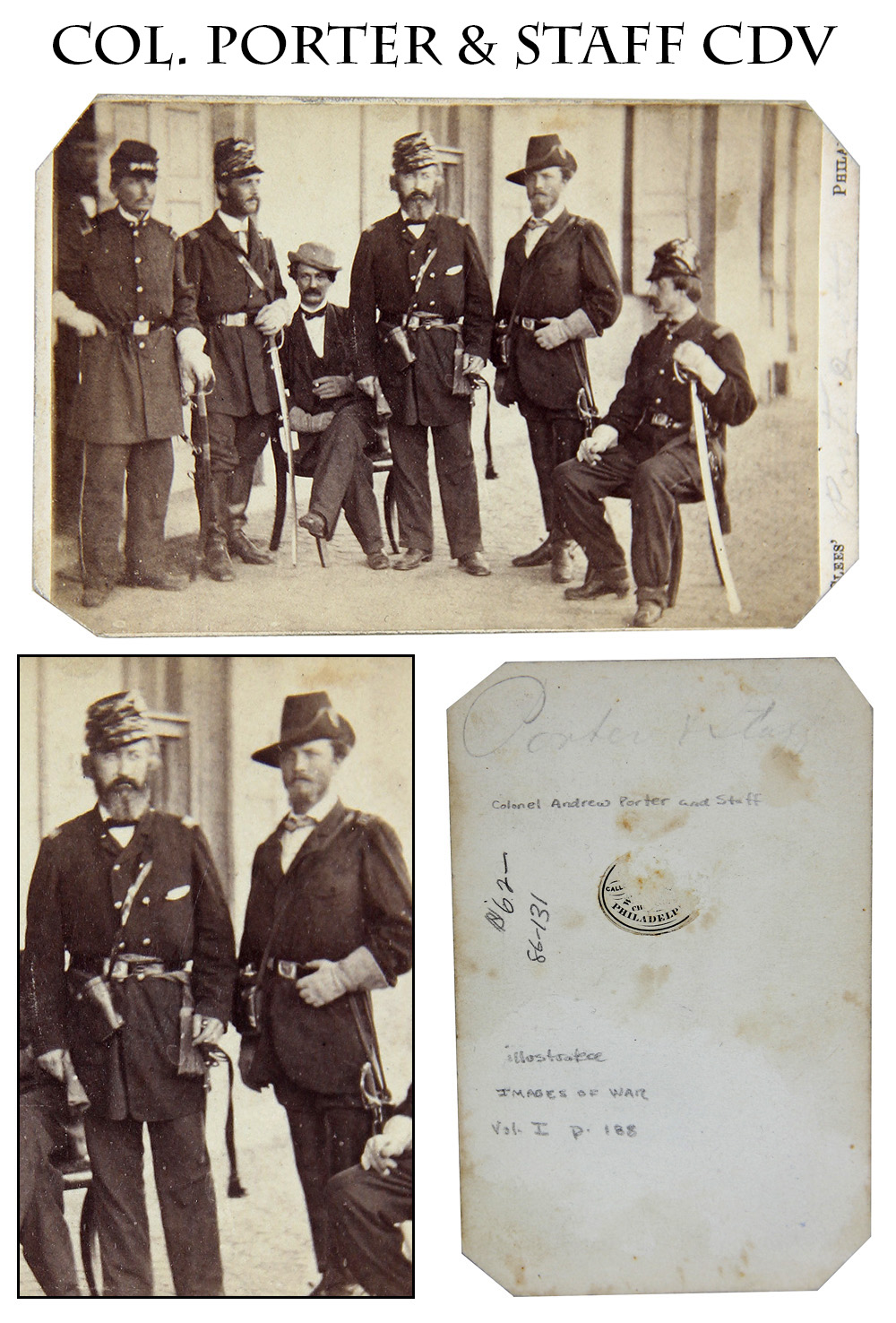
16-02-06 … CDV PHOTO ANDREW PORTER AND STAFF ON THE EVE OF FIRST BULL RUN … Crisp horizontal outdoor view of Colonel Andrew Porter and staff taken just before the Battle of Bull Run. A crisp view with great tones. The men stand on the long porch of a house and are ready for field service. Fatigue blouses and binoculars are prominently displayed. Porter and two of his officers sport tall McDowell style forage caps with rain covers. They look ready and anxious to teach the Rebels a lesson. Porter fought in the Regiment of Mounted Rifles in the Mexican War and spent fourteen years serving in Texas and the southwest afterward. Appointed Colonel of the 16th US Infantry at the beginning of the Civil War, at Bull Run he commanded a brigade in Hunter’s Division, which formed McDowell’s flanking column in a plan to hit the Confederate left by way of Sudley Ford. Porter led his brigade into the fight in support of Burnside in the attack on Matthews Hill and took over the division after Hunter was wounded. Soon after the battle he was appointed brigadier general of volunteers, serving as Provost Marshal of the Army of the Potomac during the Peninsular Campaign. Porter resigned in the spring of 1864. The corners of the card were clipped for album insertion and the Philadelphia photographer’s marks are partly obscured, but there is no loss of subject matter. A crisp, and very scarce early-war outdoor view … $350.00 – SOLD
Call us @ 419-842-1863

16-02-07 … 1865 DATED AMES CAVALRY SABER … The classic Yankee trooper’s saber, made and marked by Ames at the ricasso with their scroll logo on one side and US over JCW over [1]865 on the other. The lower part of the Ames scroll is a tad light and the “1” in the date is faint, but there is no doubt about the stamping. Very nice, untouched, aged patina to the brass and full original leather and wire on the grip. Blade is in the bright, with good edge and point, but toned to subdued silver overall. The leather pad is in place under the guard and the knuckle bow is stamped “F 1 6 4,” which is likely a company letter, regimental numeral and rack number. With an 1865 date it is possible this sword made its way into the field at the end of the war, and even more likely it saw service in the early Indian War army. The scabbard is complete, in good condition, and shows a natural graying of an untouched bright surface. Great for a Civil War or early Indian War cavalry display. Very respectable example … $595.00 – SOLD
Call us @ 419-842-1863

16-02-08 … AMES FOOT OFFICER’S SWORD IN EARLY WAR AMES METAL SCABBARD … The regulation Civil War infantry line officer’s sword. Carried by lieutenants and captains, this pattern was adopted from the French and introduced into US regulations in 1850. Complete sharkskin grip and wire, untouched brass hilt. Blade is bright with delicate etching of floral motifs, an American eagle and national motto on one side and a “US” on the other. Slightly rubbed but visible above the ricasso on one side is the Ames / Chicopee logo etched just beneath a patriotic American shield and assortment of arms. Very few Ames foot officer’s swords are found in steel scabbards. Most came with leather sheaths. This is a very rare and early pattern Ames brass mounted steel scabbard in VG solid condition. The blade is very nice, no nicks. The scabbard drag shows it was actually worn in the field- the drag is worn down slightly from occasionally dragging along the ground when the officer neglected to place it on the carrying hook of his sword belt. A nice variation of the regulation foot officer’s sword worthy of a Civil War or Amercian edged weapons collection or even the more specialized Ames collection. Compare the same sword at $1650 on the Gutterman page … g-15491 … $1,150.00
Call us @ 419-842-1863
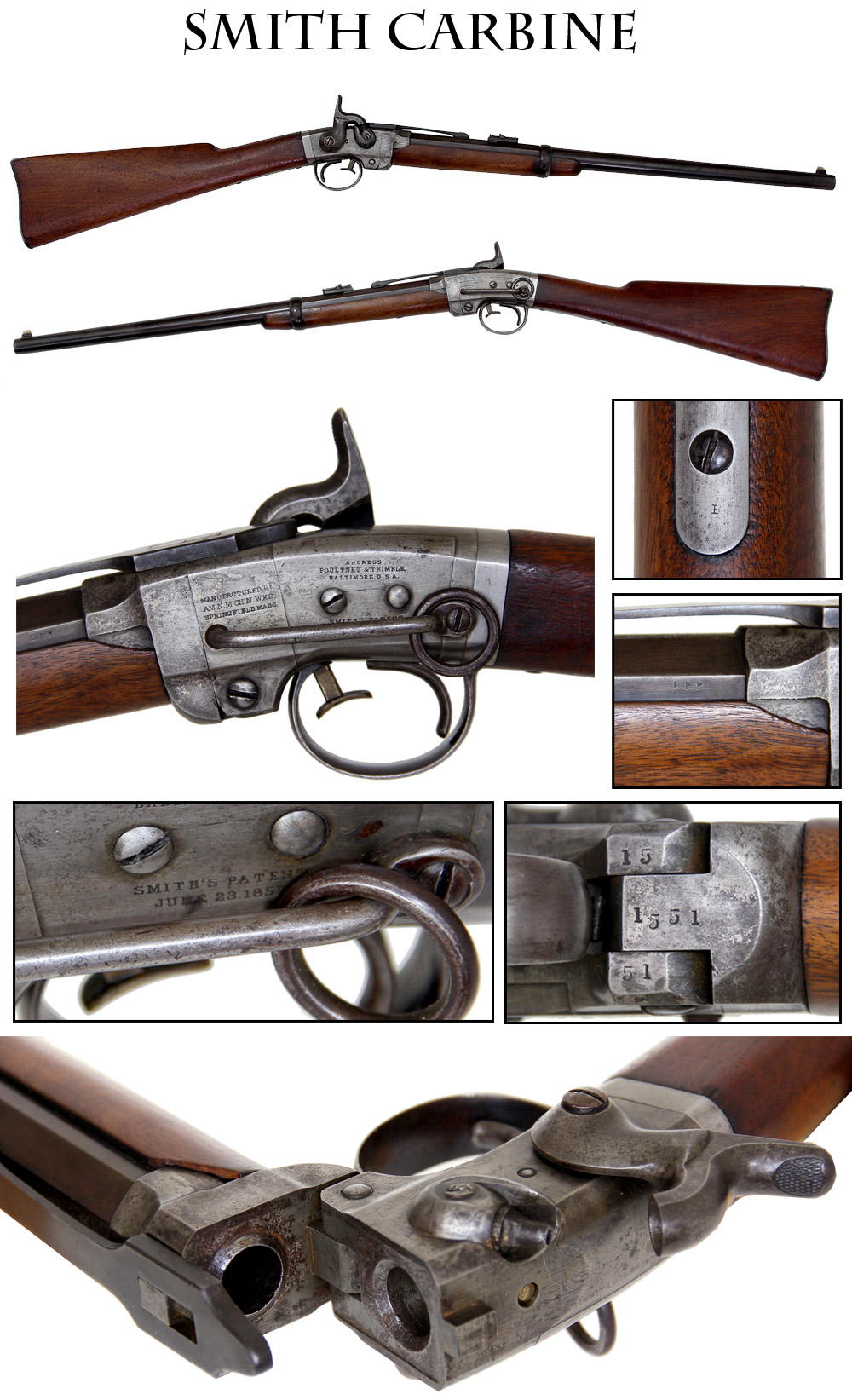
16-02-09 … FINE CONDITION AMERICAN MACHINE WORKS SMITH CARBINE … A very nice looking Smith carbine manufactured by the American Machine Works (one of three manufacturers of this arm) and so marked on the left of the receiver along with the Smith patent information and Poultney and Trimble agent markings. There are two small chips at the upper corners of the forend where it joins the receiver … which is not uncommon; otherwise the wood is extremely nice. There is loads of blue on the barrel, barrel band, sight and locking bar. The mechanism is good and the gun locks up tight. Sling bar and ring in place. Receiver and ferrules silver gray. Matching serial numbers 1551. Excellent bore. No cartouche, so likely a commercial example sold by Schuyler Hartley & Graham. These were popular weapons during the war and carried by the 7th Illinois, 1st Connecticut, and 17th Pennsylvania cavalry among other units. This is much better than the average example available out there on the market …
noco … $1,595.00 – SOLD
Call us @ 419-842-1863

16-02-10 … 21st OHIO SOLDIER’S HUNTING CASE KEY-WIND POCKET WATCH … This watch has had but two owners since the family of the soldier sold it. The soldier was Thomas Alexander Williamson… aka Alex Williamson 21st and 182nd Ohio regiments. In June of 1999 I personally bought this watch at the family estate auction in Waterville, Ohio. Later that year I sold it to a collector friend in New Jersey. He kept it sixteen years until late 2015 and then traded it back to me toward a sword he wanted. I was glad to get it back…. it was like seeing a long lost friend. Back in 1999 I had a shop in Waterville and followed local auction listings. Whalen Auctioneers in Whitehouse, Ohio advertised an on premises estate auction with this Civil War watch as one of the offerings. I attended the sale and was the high bidder. I spoke with the family members and was able to get a copy of a tintype of Alex Williamson that the family retained. I also got a veteran’s letter and a GAR ribbon which are included here. When the auction began there was an old envelope holding the watch with a note on the front detailing the soldier’s name and history. After an hour or two into the sale the envelope either fell off the table or blew away and could not be found. I obtained a letter from the family verifying that the envelope existed and the ownership history. The watch is a fine full size man’s silver, hunting case pocket watch. It is in excellent condition and runs quite well. It is engraved in foliate designs on front and back. It is inscribed in the back “No. 51519 Straight Line Lever Fully Jeweled F. Sagne Nocle”. Silver case bears same number 51519 as the movement. Swiss made. I can find virtually no information on maker Sagne utilizing my best Google search skills. What I have seen.. His name was possibly Frederick Sagne and the few known specimens date to the last half of 19th century with later specimens being high grade gold examples. I can find no company data whatsoever. I did find a watch page with a gold stem wind example circa 1885 signed “Frederick Sagne Geneva” priced at $6,550.00 ! I assume that he or a successor moved to Geneva at some point. The 1880s keyless watches seem to be signed on the face of the watch whereas our Civil War era watch is not. At any rate it is a great old key wind watch directly from the family. Our owner Alex Williamson has the following data Thomas A. Williamson Residence was not listed; 22 years old. Enlisted on 4/26/1861 as a Private. On 4/27/1861 he mustered into “D” Co. OH 21st Infantry He was Mustered Out on 8/12/1861 at Columbus, OH Promotions: * Corpl 7/27/1861 AND 182nd Ohio— Enlisted on 9/2/1864 as a Sergeant. On 10/27/1864 he mustered into “K” Co. OH 182nd Infantry He was Mustered Out on 7/7/1865 at Nashville, TN Promotions: * Qtr Master Serg 3/15/1865 Intra Regimental Company Transfers: * 3/15/1865 from company K to Field & Staff.
History of the 21st Regiment: OHIO TWENTY-FIRST INFANTRY (Three Months) Twenty-first Infantry. – (Three Months’ Service.) Col., Jesse S. Norton; Lieut.-Col., James M. Neibling; Maj., A. J. Taylor. The companies composing this organization were en- rolled as follows: A, F and G, April 19, 20 and 26, respec- tively, at Findlay; B, April 23, at Gilead; C, April 25, at Perrysburg; D, April 20, at Ottawa; E, April 20, at Kalida; H, April 23, at Fostoria; I, April 26, at Elmore, and K, April 24, at Defiance. They at once proceeded to Camp Taylor, Cleveland, where the regimental organization was formed, and active prepa- ration made for the field. When the quota under the first call had been filled, it was found by the state officials that nine full regiments were in camp and had to be cared for – the 21st being one of them. Ohio being a border state and liable to in- vasion, these additional troops were mustered into the state service to provide more effectually for defense. On May 23, the regiment moved to Gallipolis, stopping at Columbus for arms and accouterments. It remained in camp until July 3, when it was ordered to Ravenswood, W. Va., by Gen. McClellan, to rein- force other troops there, expecting an attack from O. J. Wise, whose forces were at Ripley. It made a forced march to Ripley, surprised and drove the Confederates away, and then returned to Gallipolis by steamer. On July 11, it became part of Gen. Cox’s brigade and marched to Red House, on the Kanawha river, where it was ordered to make a reconnaissance for the purpose of discovering the Confederate position. It performed gallant duty at Scarey creek, where Col. Norton led the forces in a successful bayonet charge and received a painful wound through the hips. The enemy was reinforced and advanced his column, capturing Col. Norton and Lieut. Brown, of the 12th Ohio, who remained with the colonel and the other wounded. The regi- ment’s loss in this battle was 2 killed, 2 mortally and a num- ber slightly wounded. It remained in the field under Lieut.- Col. Neibling, until ordered home to be mustered out, which oc- curred on Aug. 12, 1861, at Columbus. Its casualties during its term of service was 4 men killed in battle, 3 drowned and 8 died of disease. History of the 182nd : OHIO ONE HUNDRED EIGHTY-SECOND INFANTRY Col., Lewis Butler; Lieut-Col., John A. Chase; Majs., William W. West, Amos S. Whissen. This regiment was organized in the state at large from Aug. 4 to Oct. 27, 1864, to serve for one year. On Nov. 1 it was ordered to Nashville Tenn., and on the 6th joined Gen. Thomas’ forces at that place. The regiment took part in the battle of Nashville, where it remained performing guard and provost duty until July 7, 1865, when it was mustered out in accordance with orders from the war department. A great Soldier’s Watch with much provenance … $950.00 – SOLD
Call us @ 419-842-1863

16-02-11 … DID SOMEONE ASK FOR A DERINGER? 1830s CANNIBALIZED MARTIAL PISTOL … This is probably not what the riverboat gambler had in mind when he heard “Deringer”. A competent armorer or gunsmith back in the 1830s has taken a decent Deringer marked lock from one of his 1817 Common Rifles and fitted out a European (probably French) military pistol with it. The original pistol shows some nice graining on the grip and shows a lanyard ring on the flat butt cap. A single iron band, likely from a musket, secures the barrel and a proper new made wood ramrod has been added. The lug for a military swivel rammer assembly is still present below the muzzle. Roughly 69 caliber. A long-bladed front sight is in place, though you probably needed to be within spitting distance to hit anything with this smooth bore pumpkin hurler. (Or you could load it with shot and be the most dangerous desperado in the room.) No reason you couldn’t use this in a display of weapons that might have been at the Alamo. Neat old war horse. The original lock in this pistol is worth the price of admission if you need one … bej-16883 … $665.00 – SOLD
Call us @ 419-842-1863

16-02-12 … MOORE REVOLVER WITH FIVE INCH BARREL … The seven-shot Moore revolver was a popular sidearm for officers in the Civil War. Firing the self-contained .32 caliber rimfire cartridge meant an officer did not have to worry about fumbling around for percussion caps or worry about wet weather. The company made some 5,000 to 8,000 of these revolvers in Brooklyn from 1861 to 1863, until it went out of business for infringing Smith and Wesson’s patent. This revolver, numbered 6748, bears the scarce barrel mark “Mf’d for Smith & Wesson by Moore’s Patent Firearms Co.” which shows that it is one of the guns sold after the court judgement and part of the settlement to S&W. The brass frame and backstrap have a beautiful aged, mellow tone and show the characteristic elaborate Moore engraving well. The ejector rod is in place and the mechanism is good. The barrel shows a lot of plum patina from oxidized blue and some light gray metal showing through along the edges. The markings on barrel, frame and patent markings on the cylinder are legible. The wood is very good and is tight to the metal. Some of the original silver remains on the forward trigger guard tang, with a small bit at the tip of the frame and around the screw heads, otherwise it has a nice even brass tone. A very attractive revolver. All original and complete and mechanically perfect … cbe-17067 … $895.00 – SOLD
Call us @ 419-842-1863

16-02-13 … 1818 STARR SABER AND SCABBARD … Starr 1818 Contract Cavalry Saber. The US government contracted for 10,000 of these weapons in 1818 and they were delivered between 1820 and 1822. This one has the regulation 32-inch blade with the characteristic broad fuller, and absolutely no nicks or dings. Stampings are slightly worn on the right, but clearly read, “US / P / LS / N Starr” indicating the sword was inspected by Luther Sage. The back strap and guard show a mix of deep gray and the original black japanning. The leather washer is missing from the blade shoulder, but the grip still retains about 70 percent of its leather wrap, which is usually missing entirely. The scabbard is in superb shape, is proper for this saber (this contract didn’t have a throat) and preserves most of its original blacking. The carrying ring mounts on this pattern were simply soldered to the upper edges of the scabbard, a rather fragile arrangement. The blade is bright mixed with some gray areas about two-thirds of the way back from the point and some rougher brown spots in the first couple of inches from the guard. A nice early US government contract cavalry saber. An extremely affordable piece of Americana … now nearly 200 years old … cae-jpal … $535.00 – SOLD
Call us @ 419-842-1863
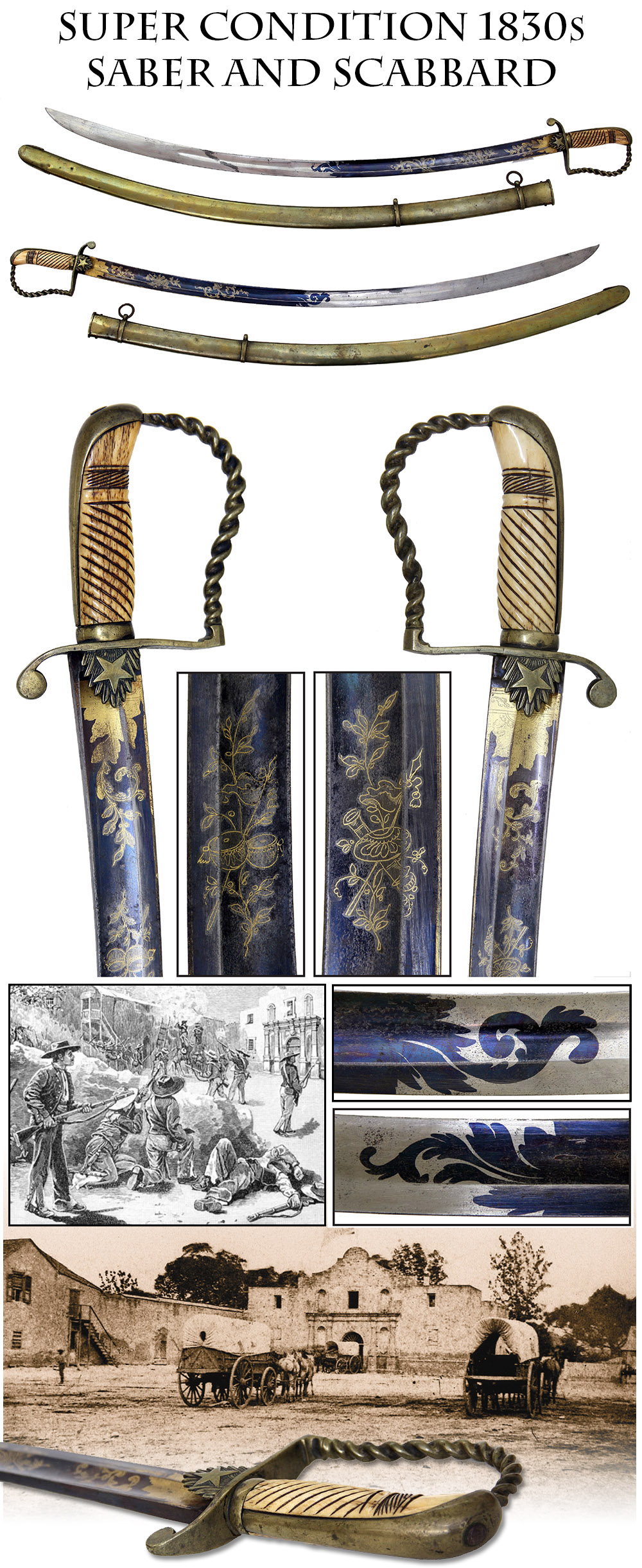
16-02-14 … SUPER CONDITION 1830s SABER AND SCABBARD WITH HINT OF TEXAS … Beautiful Alamo era mounted officer’s saber with 36 inch long blue and gilt blade. Incised carved bone grip with brass hilt incorporating a back strap and knuckle guard imitating twisted rope. The counter guard and quillon are simple and flat, setting off the langets which are in the form of sunrays flaring out from the guard with a superimposed five-pointed star on each. The lone star certainly imparts a gentle nudge of a connection with Texas, though certainly not conclusive. The blade is blued for about 1/3 its length, terminating in a floral swirl, and lightly engraved with floral and military motifs that are in turn gilded. The blue is still vibrant, as is the gilding. This is a beautiful blade. Some very minor graying about 1/3 back from the tip that is barely noticeable. Excellent edge and tip. The scabbard is brass with beautiful mellow toning. Upper ring and throat are in place. The lower ring is missing from the band, but who cares? This can be fashioned easily from a length of medium gauge brass rod. Some date this form of sword as early as the War of 1812, but it is actually of the 1820 to 1840 period. More than a few collectors attribute the star on the langets to the early days of Texas independence, the Alamo, and the “Lone Star Republic.” Whoever carried it certainly would have made an impression. This is one heck of an impressive saber … ijj-jpal … $1,650.00 – SOLD
Call us @ 419-842-1863

16-02-15 … MODEL 1873 WINCHESTER RIFLE WITH RARE 30 INCH BARREL AND SET TRIGGER! … Made in 1884… The classic “gun that won the west:” the 1873 Winchester lever action rifle. Very nice example in .32 caliber with custom features of a set trigger and 30-inch barrel. Serial number 126814A. This was manufactured in 1884. Overall VG condition with matching age brown patina overall. Both sights in place, action good. Tight wood to metal fit. Wood is pleasing dark brown in tone. Hairline crack on right side of the butt stock that goes back and over the wrist just forward of the comb. This stress line is a century old and completely stable. Mellow tone to the brass carrier. Nice example of the rifle most closely associated with romance and myth of the old west. Finding these with the long 30 inch barrels is a memorable event. (Standard barrel length is 24 inches.) Bore is decent. This would have been a great long range rifle back in the cowboy days. A classic American Winchester … agfj … $2,250.00 – SOLD
Call us @ 419-842-1863

16-02-16 … Tintype, Belt Plate and letters of Danial O. Clough, 23rd New York … I obtained this lot directly from the family in two installments. Nicknamed the Southern Tier Rifles, the 23rd was one of New York’s two-year regiments, raised and rushed into service by the state before the US government set the enlistments at three years. Daniel O. Clough was 32 years-old when he enlisted at Cortland, NY, on 5/8/61 and mustered in on 5/16/61 as a private in Co. H. He made it to corporal before being busted back to private, but thought enough of his rank to keep his NCO belt plate as a souvenir. He was mustered out in Elmira on 5/22/63. The regiment served with the Army of the Potomac and Pope’s Army of Virginia. They saw action at Fair Oaks, Second Bull Run, South Mountain, Antietam and Fredericksburg, losing 17 enlisted men killed or mortally wounded in battle. The set consists of 15 letters, his early war eagle buckle with 3-piece silver wreath, and a nice sixth plate tintype in uniform. The letters include some excellent letters to his family, and a couple from family members … in one, a family member writes to a niece Anna, writes of President Lincoln’s assassination: “… The last two days have been very sad here. Saturday morning in the dispatch came of the awful tragedy at Washington and all business was suspended and men and women were suffering as though they had lost their own family. the President is to be brought to Illinois for burial. It followed so soon on a great day of enjoying last Monday. The flags were flying on buildings and ?? and cannons firing all over the county and Saturday black flags were flying and passenger trains were draped in black their whole length and doors with crape on them. Illinois and New York have lost their best son and God only knows what will the consequences of it …” In another, our soldier writes to his mother: “… I with two others have been scouting around this morning and have sloped to a large white house. It belonged to a secessionist and they have all run. They left it in charge of an old negro. We have took possession of the parlor and center table and three large arm chairs and am enjoying myself very much in writing to you …” August 1st 1861 he writes … “… last Sunday we woke up with the cry Fall-In Fall-In. The whole regiment was in line of battle in less than seven minutes. The cause of the alarm was ten of the rebels picket attacked our picket guard. Our men killed seven of them and took three prisoner. … There is probably 40,000 soldiers in sight of us and we are going to whip the devil out of them rebels next time… ” Other letter content includes marching, trips to the hospital, newsy observations, etc. … A great lot of items offered publicly here for the first time. … $895.00 – SOLD
Call us @ 419-842-1863

16-01-17 … SPENCER INFANTRY RIFLE /SPRINGFIELD ALTERATION FROM CARBINE … One of only 1,108 such guns produced circa 1871. Springfield took the M1865 Spencer carbines and altered them to 2-band infantry rifles. This one overall VG condition. 100% original 100% complete except for sight leaf, and mechanically perfect. All markings clear. Serial number 4522. Wood has been varnished. Steel surfaces mostly smooth gray steel. Some spots of pitting on left side of frame, not offensive. Has proper rod and proper rear sight but rear sight lacks the elevation leaf. A darn scarce Spencer arm and perfect for early Indian War display. Great bore … ajjj-15-11-28 … $1,395.00 – SOLD
Call us @ 419-842-1863

16-02-18 … CIVIL WAR INFANTRY CARTRIDGE BOX RIG WITH SLING AND PLATES … The Yankee foot-slogger’s essential ammo rig. A .58 caliber cartridge box complete with both tins, original shoulder sling, and both the cartridge box plate and the shoulder belt plate. The box is nicely marked by H.W. Oliver, an accouterment maker and contractor in Pittsburg. The box has its belt loops, buckles and latch tab in place. The outer flap has the oval US cartridge box plate that was intended to keep the flap down even if the soldier unlatched it in action. The old leather thong that held it is long gone, but there are traces of it showing on the leather. The latch tab is secured by both stitching and a rivet. The leather shoulder belt is in place, solid, flexible and still has a lot of finish left on it. 98% of the time these straps are missing. Attractive muted color to both plates. The only defect I see is that the divider of the upper tray in one of the tins is missing, not uncommon since they were just soldered in place. A nice rig, not easy to find any more, but an essential piece of Civil War infantry field gear. Very hard to find these days … h-or-i-160125 … $1,195.00 – SOLD
Call us @ 419-842-1863
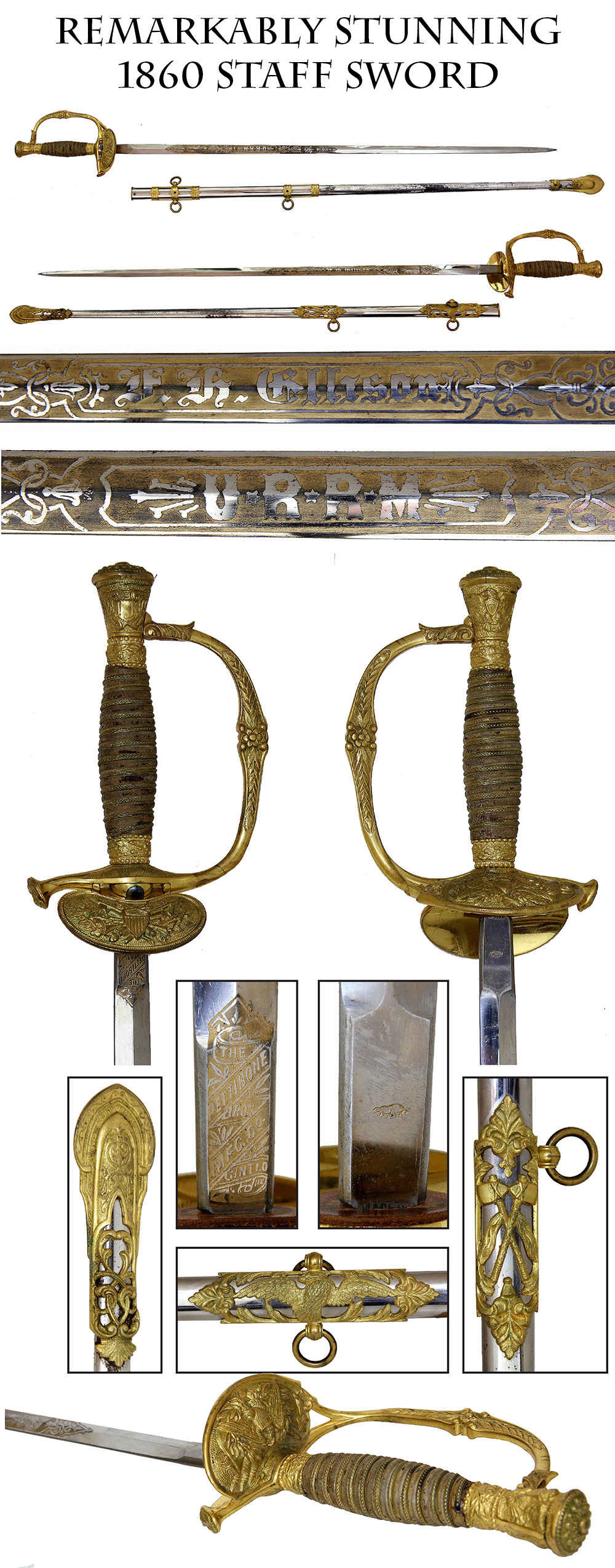
16-02-19 … F.R. BEAUTIFUL 1860 STAFF AND FIELD SWORD BY PETTIBONE … The 1860 pattern staff and field sword was a beautiful sword that remained popular for several decades. This one was made and marked by Pettibone of Cincinnati with a gilded and etched blade for a member of a fraternal organization. The scabbard is bright brilliant plated steel with ornate open-work brass mounts that preserve most of their gilding. The upper mount has a spread-winged American eagle incorporated in it and the middle mount a pair of crossed stone axes or tomahawks that seem to sport horsehair fetishes as well. The scabbard has a couple of gray patches below the middle mount, but still shows very nicely. The hilt has a nice even tone to the brass that preserves a lot of muted gilt. The folding guard is functional and the wire is in place on the grip. The sharkskin wrap is there, though worn smooth from handling for the most part. The blade is stellar. Bright with fully intact gilt embellishments, the ricasso shows the Pettibone logo on one side and a stamped walking bear on the other, which is probably the blade maker. Each side of the blade has a gilt and bright etched panel of geometric and floral motifs. One side has the owner’s name: “F.H. Gibson.” The other side has the organization’s initials, “U*R*R*M” This combined with the crossed stone hatchets suggest we are looking at a sword for a “Uniform Rank [Order of] Red Men,” at least that’s my guess. Whatever organization he belonged to, Mr. Gibson must have showed off very well with this sword. A very showy sword with infinite eye appeal … cej … $295.00 – SOLD
Call us @ 419-842-1863
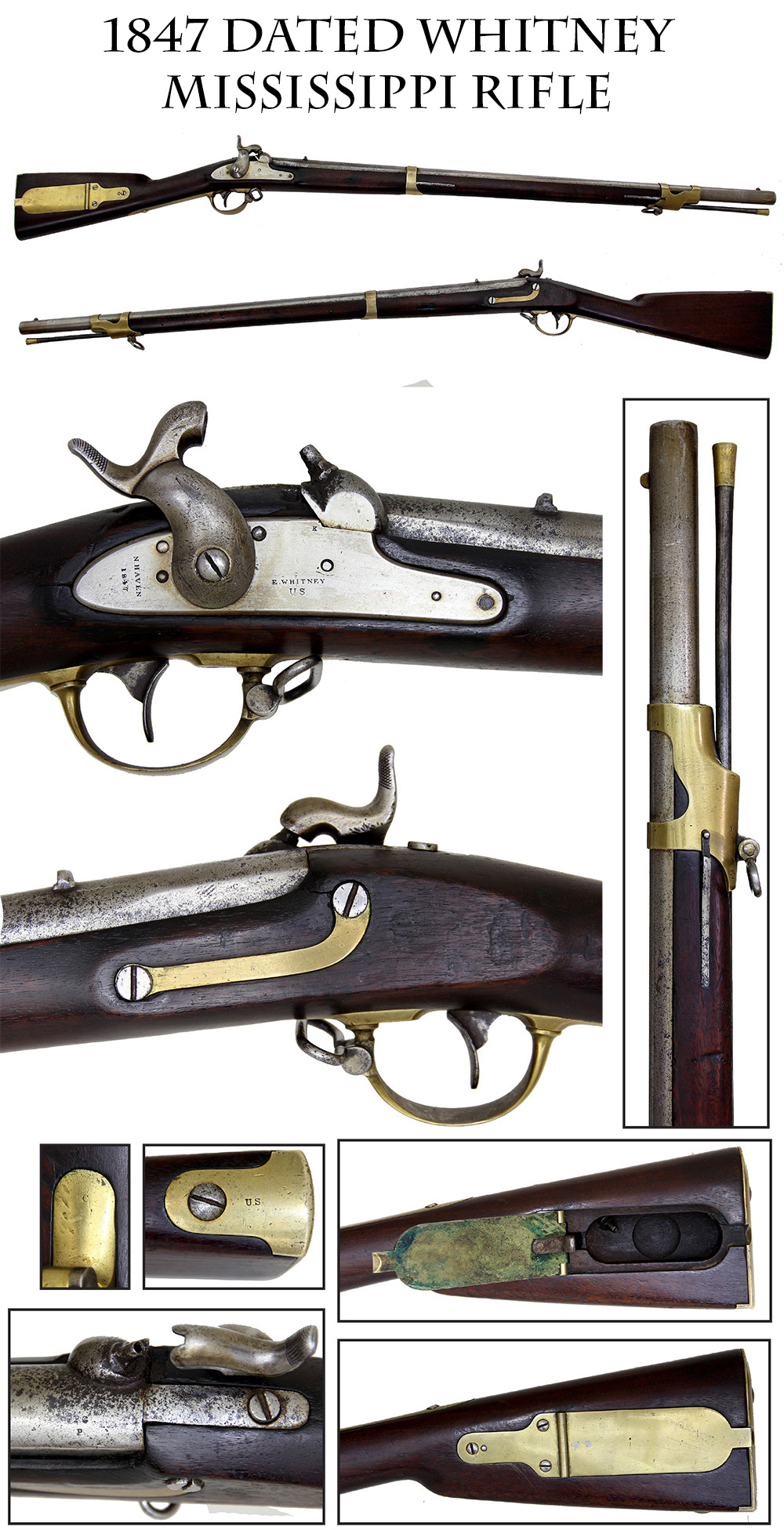
16-02-20 … MEXICAN WAR DATED MISSISSIPPI RIFLE BY WHITNEY … The Model 1841 rifle gained fame and a nickname from its use by Jefferson Davis’s Mississippi Rifle regiment in the Mexican War, but its tough to find one that actually dates to the period. Here is a Whitney contract example, one of 900 he made in 1847, at the tail end of that conflict, but while fighting was still going on. Whitney made some 26,500 between 1843 and 1855, and later confessed that his production costs had been so great he never made much of a profit on them. The lock on this one has a nice clear E. Whitney/ US forward of the hammer and N. Haven/1847 behind it. Sights, bands, rod and swivels are all in place. The barrel is a smooth silver-gray with some darker gray spots mixed in overall and some firing corrosion around the nipple from the percussion caps. The bore is original .54 caliber with very good rifling. The brass has an even medium tone and the wood is good, showing only honest handling age. There are two slight checks around the lockplate. Two cartouches are faintly visible on the left side of the stock opposite the lock, mixed with some dings and bangs, Barrel inspector initials and proof “P” are visible. I see no US or barrel date on the breechplug tang. A good solid Mexican War dated Mississippi in original .54 caliber … i … $1,950.00 – SOLD
Call us @ 419-842-1863
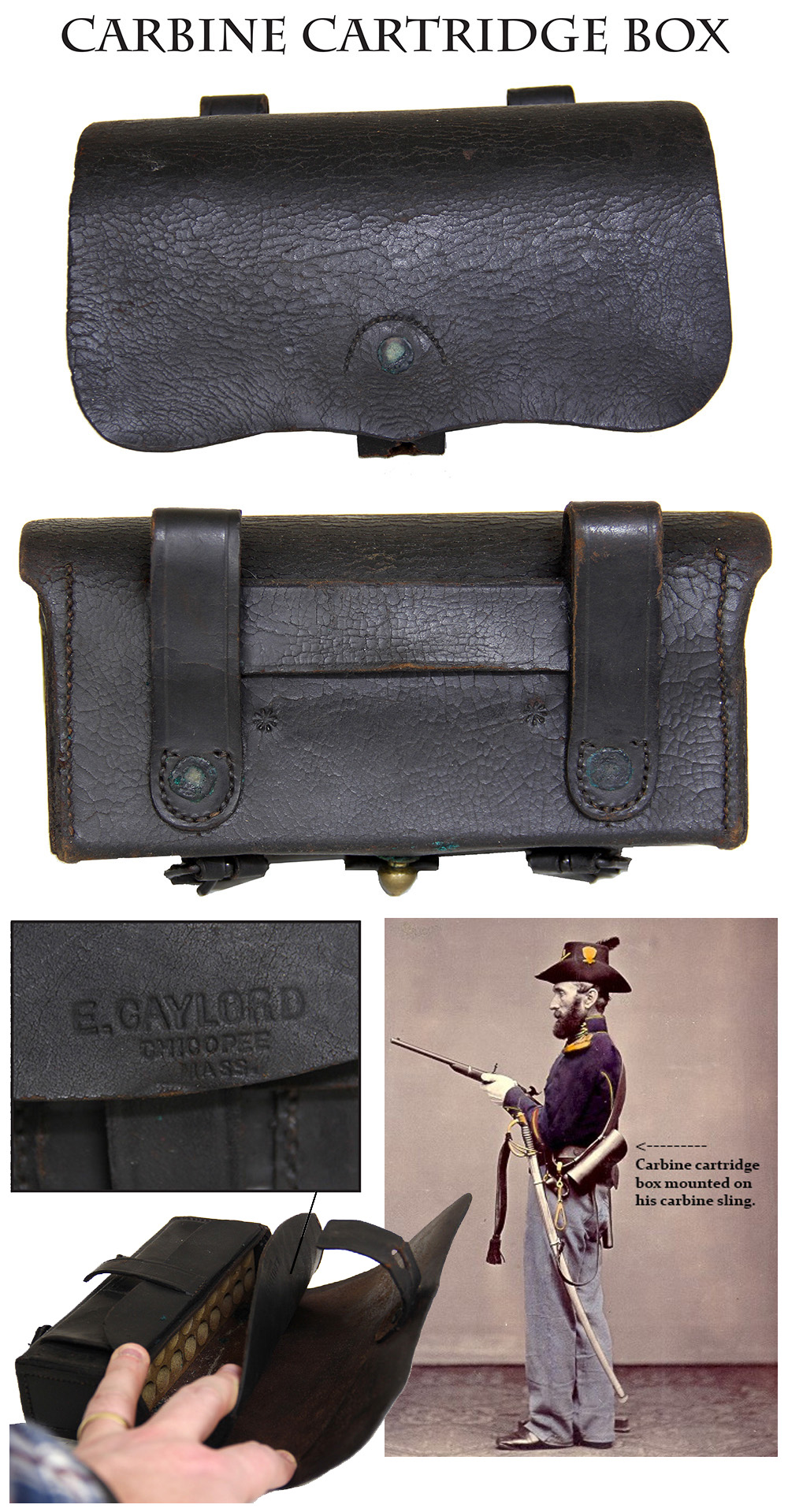
16-02-21 … CARBINE CARTRIDGE BOX BY GAYLORD … Regulation issue cavalry cartridge box for the carbine. Where the infantry boxes used tin magazines to keep the cartridges intact, the cavalry relied on old-style drilled wood blocks, which made a lot of sense given how much jostling the ammunition was likely to take while the trooper was mounted. This example is in top notch condition with all its finish, and just the usual overall “crazing.” The latch tab, belt loops and buckles are in place and secure. The Gaylord maker’s stamp on the inner flap is crisp, the implement pouch and its cover and tab are there as well. A great example of key accouterment for the Yankee trooper no matter what carbine he was issued. This is one of the better examples of this cavalry accoutrement that I have owned in several years … cjj-15204 … $395.00 – SOLD
Call us @ 419-842-1863
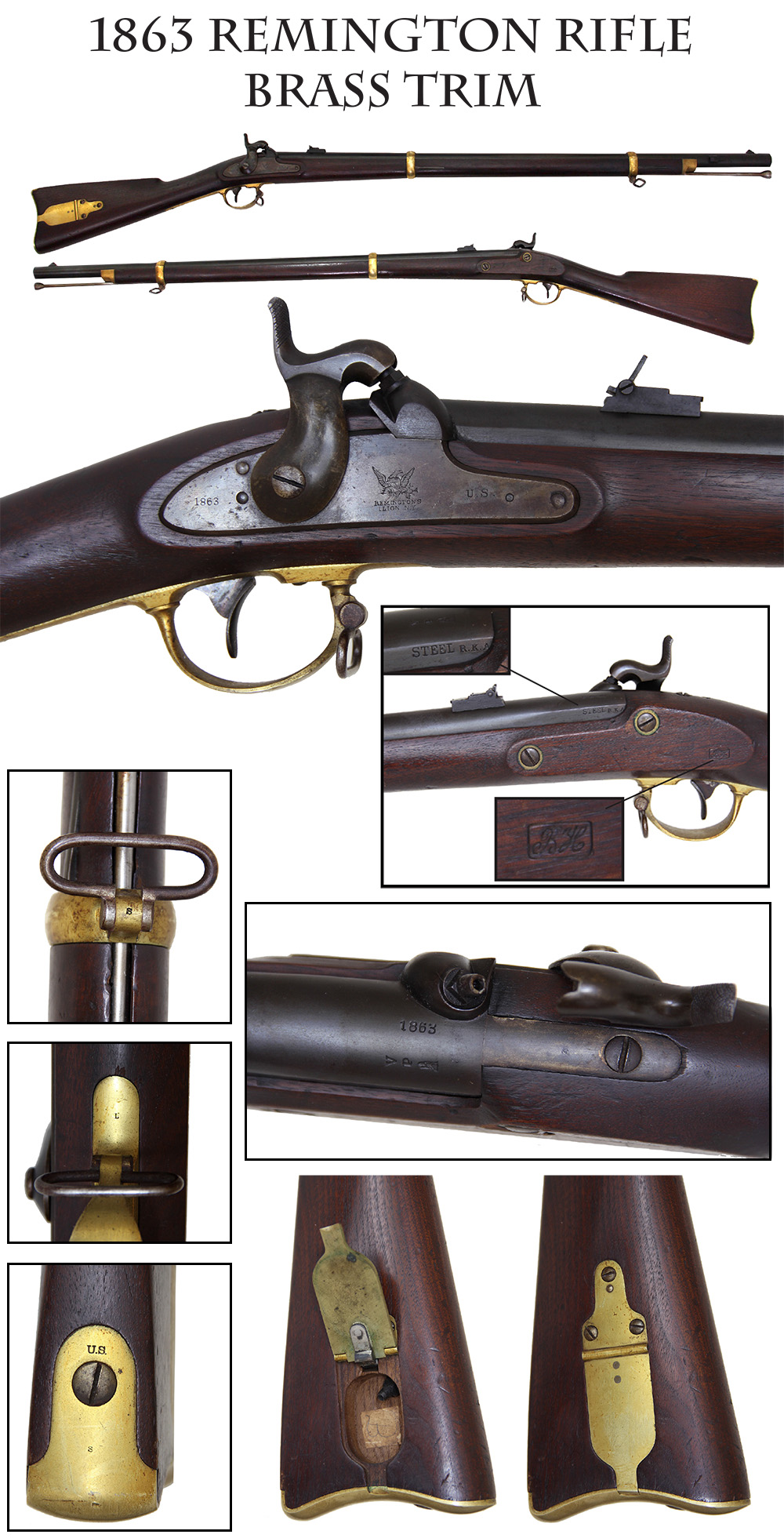
16-02-22 … NEAR MINT REMINGTON ZOUAVE RIFLE … A top shelf example of the brass mounted, blued steel, Remington 1863 Percussion Contract Rifle, popularly known as the “Zouave Rifle”. Their use is still something of a mystery, but Remington produced some 12,501 of them from about 1862 to 1865. Clearly based on the old rifle patterns used by the Mississippi and 1855 Harpers Ferry rifles, the Remington retained the patch box. This one is excellent: sharp lock markings, barrel proofs and matching 1863 dates on lock and barrel. Beautiful muted barrel blue, almost 100% with just some gray showing through at the edges of the breech plug tang. Sharp wood with crisp “BH” cartouche on the left side. Very minor old chips at the ramrod channel and a little around the breechplug tang. Medium tone to the brass. Signs of case color on the lock with just slight gray showing just below the hammer. Near mint bore with seven groove rifling. “Steel” barrel stamp with barrel inspector initials on the left. Swivels, springs, bands, rod, sights and bayonet lug in place. Extra nipple still inside the patch box. An attractively priced example of a really attractive rifle … ybcjj-allis-17243 … $2,850.00 – SOLD
Call us @ 419-842-1863
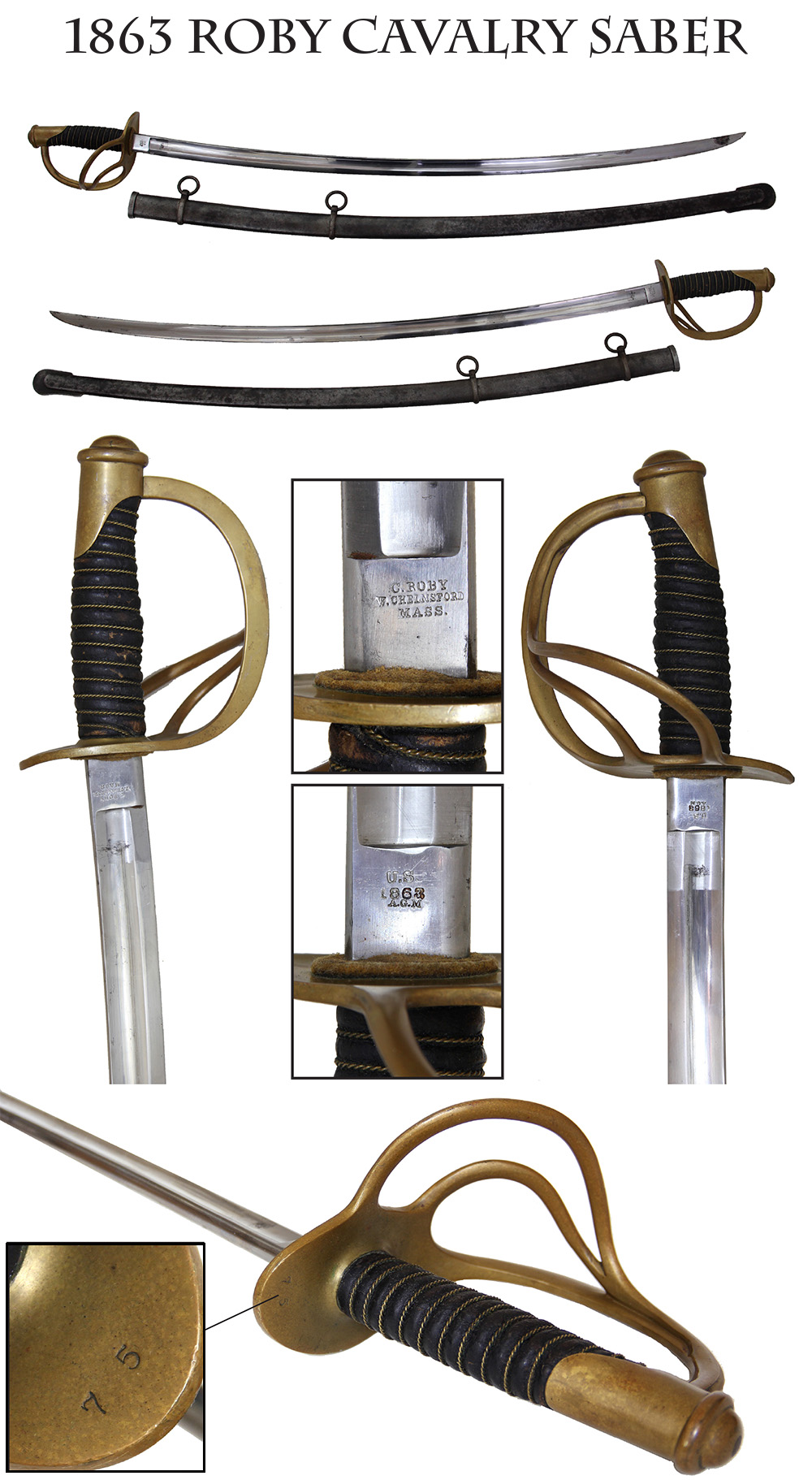
16-02-23 … EXTRA NICE 1863 DATED ROBY CAVALRY SABER … This saber has two SUPER features… a near mint blade, and the highly desirable date of 1863. This is a crisp example of the regulation Union cavalry saber. Introduced in 1857, the light cavalry saber was the regulation sidearm of Yankee troopers. Roby was one of the more prolific suppliers and this is a fine example of his work with a mid-war 1863 date. The grip has full original leather and wire with some expected scuffs and bumps on the leather. There are a couple small spots where it has rubbed through to the wood. It retains the pad beneath the guard, full scabbard, and a near pristine blade in the bright. SUPER BLADE! The Roby blade address is crisp as is the US/1863/A.G.M. stamp on the other side of the ricasso. The blade even shows the desirable original cross-polishing at the ricasso and for an inch or so above that collectors scramble after. To top it off, the saber was actually issued: the rack or trooper number “75” is stamped on the inside of the upper guard. There are a couple of small gray spots above the ricasso and a couple more light patches near the tip, but not much to disturb the overall near mint impression of the blade. The scabbard is silver/gray with a dusting of darker gray and brown overall. One of the better cavalry sabers I’ve been able to offer in recent months … f-17034 … $795.00 – SOLD
Call us @ 419-842-1863

16-02-24 … MODEL 1866- SECOND ALLIN CONVERSION – TWO BAND RIFLE … The 1866 pattern rifle introduced some improvements on the Model 1865 Allin and about 25,000 were produced at Springfield by altering Civil War M1863 percussion muskets. These guns were finished “in the bright” and utilized the trapdoor breech and a .50 caliber sleeve liner to fire a centerfire cartridge. Ours has the correct 1866 over an eagle’s head stamped on the breechblock and an 1864 dated lock. Sights, bands, rod and swivels are all in place. The barrel is 32 inches overall (29 to face of breech) and sports two barrel bands. This likely done by military outfitter or surplus dealer in the late 1800s. It was nickel plated during its period of service … likely by a GAR Hall or VFW Post for parade use. Condition is about good. Worn but complete. The mechanism is good and the markings are clear. The wood is tight to the metal though it shows rounded edges from handling. Some of the plating has flaked on the hammer and breech- pretty typical for moving parts and not obtrusive. A most affordable antique military rifle from the early Indian Fighter era … bfj-00000 … $365.00 – SOLD
Call us @ 419-842-1863

16-02-25 … IDENTIFIED SOLDIER CARVED 18th PENNSYLVANIA CAVALRY BURNSIDE CARBINE – FARNSWORTH’S CHARGE! … Identified / Inscribed Burnside carbine. This is the “standard 5th model” Burnside for Civil War cavalrymen, distinguishable from the other Burnsides by the placement of a guide screw for the breechblock on the right side of the frame. These guns are marked “Model of 1864” on the top front of the breechblock, but production seems to have actually taken place starting in 1863. (Perhaps it was a bit like some copyright dates.) In any case, it is “an anomaly yet to be explained,” as Flayderman phrases it. These carbines were numbered in their own serial number range and this one has the extremely low serial number 2801 on the block and frame, making it a very good candidate for actual 1863 manufacture. The metal is silver-gray overall. The metal is generally smooth with signs of an old cleaning. The markings are very visible. Burnside stamp on the lock plate very good, serial numbers very good, model designation on the block a bit light but legible. Sights, sling bar and ring in place. Wood very good with two cartouches that are very visible, though not fully legible. Tight wood to metal fit. On one butt flat a dead-real soldier inscription is scratched in: “J.C. Snedaker / Co. D 18th Pa.” James C. Snedaker enlisted as a private 9/20/62 and mustered into Co. D of the 18th PA Cavalry the same day. He served with them until the fall of 1864, when he transferred to the Veteran Reserve Corps on or about 10/1/64, and remained with them until discharged 6/28/65. The 18th Pennsylvania Cavalry started recruiting in late 1862 and joined the army in Maryland in early 1863 covering the defenses of Washington. It spent most of its service with the Army of the Potomac and Army of the Shenandoah. At the beginning of the Gettysburg campaign it joined Kilpatrick’s cavalry division as part of Farnsworth’s brigade. As part of the cavalry maneuvering in the early part of the campaign it fought at Hanover on the eve of Gettysburg. On July 3 the regiment was part of the ill-conceived and ill-fated charge of Farnsworth’s brigade ordered by Kilpatrick in an effort to follow-up the repulse of Pickett’s charge. It was subsequently involved in the pursuit of Lee, capturing 1,000 prisoners and two cannon at Monterey Springs, and fought at Brandy Station, Culpeper, Buckland Mills and New Baltimore later in the year. In the Spring of 1864 it took part in Sheridan’s raid on Richmond and participated in picket and scouting duties before moving into the Shenandoah in August, where it fought at Winchester, Opequon and Fishers Hill in late September, 1864. A dead-real, field-used and identified Yankee trooper’s carbine. I paid nearly this price for the privilege of having this to offer here … bhjjqx-j-pro … $3,350.00 – SOLD
Call us @ 419-842-1863

16-02-26 … VERY NICE INSCRIBED MEXICAN WAR DATED US MODEL 1842 MUSKEY BY SPRINGFIELD … Last of the .69 Caliber smoothbore muskets, the M-1842 was also the first regulation musket in percussion and enjoyed the distinction of being the first to be made at two national armories and have interchangeable parts. This is the classic infantry weapon of the Old Army, developed on the eve of the Mexican War and carried into the Civil War by soldiers on both sides, This is a nice solid example. Nice wood, not dinged up, gouged or scratched, good fit and good wood edges, with just the slightest rounding at points from handling. Incised into the left side of the butt stock is the name “J W Corbell” possibly “Corbett”. Records show two soldiers named “J Corbell” from Arkansas … one Union the other Reb… turns out to be the same man as a Galvanized Yankee. But no middle initial is shown. CORRECTION further research shows middle name is Pinkney … so not the owner of our musket. If we assume the name is Corbett there are dozens of men named J Corbett and one reb named J.W. Corbett in the 45th North Carolina. My feeling is the name is Corbell. I have no access to Mexican War rosters which may prove fruitful and profitable. I have spent hours on this research … now it is your turn. Initials “AM” scratched into the right side of the butt. Smooth metal, uniform plum brown patina overall. Barrel breech gently pitted … tang date “18—” visible … last 2 digits obliterated. Barrel proofs hidden under pitting. Sharp lock markings with very visible eagle and clear 1846 date. Screw slots good, nipple not battered at all. Original rod, bands, swivels, etc. all in place. Mechanically perfect. Smooth butt plate with clear US stamp, no corrosion. No cartouche present that I can see. A superior example all in all. Great for a US martial arms collection, Mexican War or Civil War display, or even the early frontier army … $1,250.00 – SOLD
Call us @ 419-842-1863
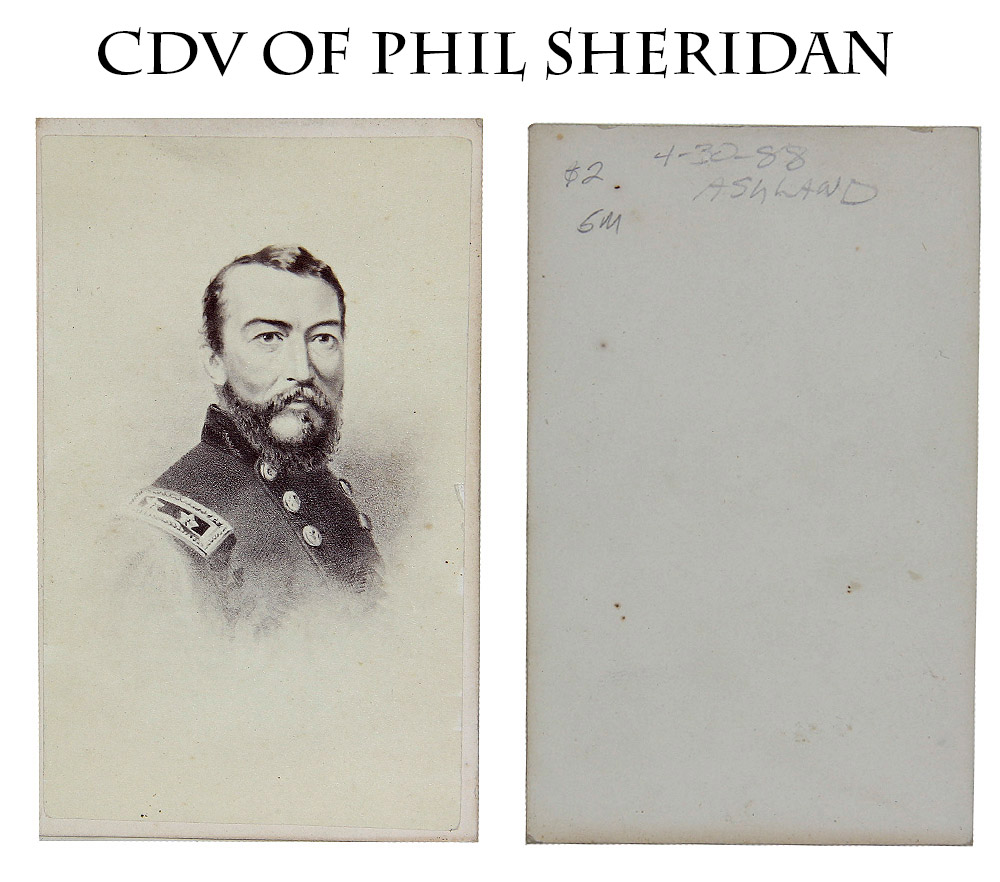
16-02-27 … CDV Litho of Gen Phil Sheridan … These CDV lithos were available for purchase by the public during the Civil War. They are still very affordable. The collector’s note on the back shows Tom bought this on April 30th 1988 at the old Ohio Civil War Show in Ashland, Ohio for $2. This year it’s … $15.00 – SOLD
Call us @ 419-842-1863

16-02-28 … CDV Litho of Salmon P. Chase Lincoln’s Treasury Secretary … These CDV lithos were available for purchase by the public during the Civil War. They are still very affordable. As I recall Chase’s portrait is found on CW Yankee Greenbacks… the US $1 Bill during the CW … $15.00 – SOLD
Call us @ 419-842-1863
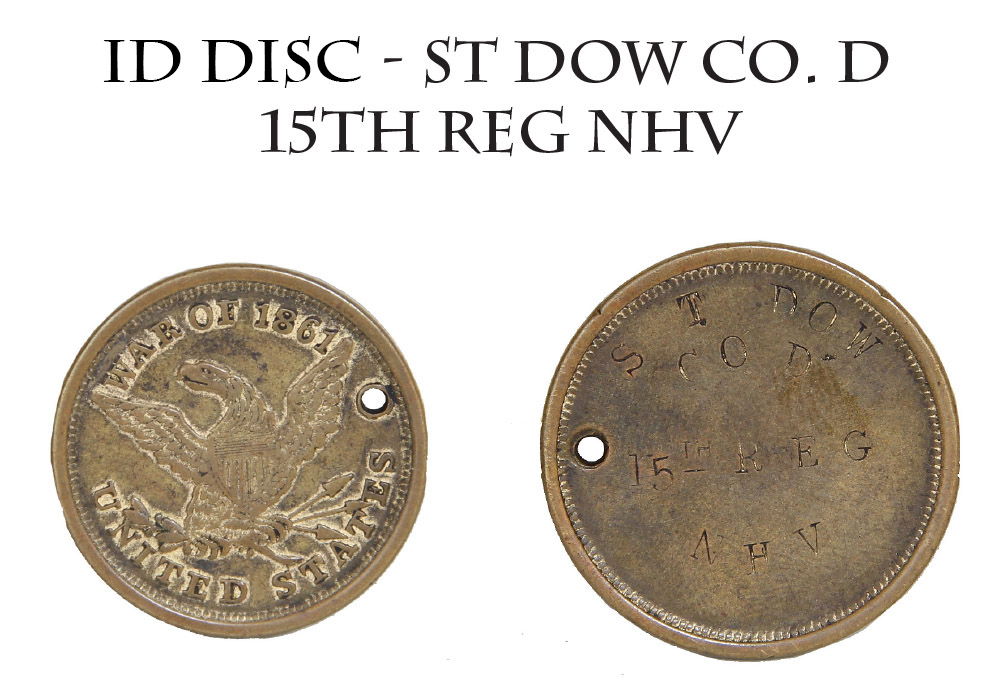
16-02-29 … Identification Disc of Samuel T. Dow, 15th New Hampshire / Served Two Hitches … The 15th NH was one of the regiments recruited for nine months service in late 1862. Many understood the duty was to be auxiliary service to enable troops already in the field “to strike the rebellion a staggering and fatal blow,” the regimental historian’s words. Such was not the case. These 9 month regiments frequently found themselves in as deadly circumstances as any. Samuel T. Dow resided in Northwood and was 22 when he enlisted on 9/12/62 as a private and mustered into Co. D of the 15th NH on 10/8/62. The regiment was assigned to the Department and Army of the Gulf, where it became part of the 19th Corps and found itself taking part in the siege of Port Hudson from late May until early July, 1863. It took part in several assaults and lost 30 of its men killed or mortally wounded during its service. At some point Dow acquired this WAR OF 1861/ EAGLE disc and had the following brief information stamped on it: S T DOW/ CO D/ 15th REG/ NHV. Dow survived to muster out with the regiment 8/18/63. He either liked army life, or the prospect of a bounty, and reenlisted in the 18th New Hampshire as a sergeant in Co. I on 2/28/65. This was a late war regiment that served in the 9th Corps during the Petersburg Campaign, losing 1 officer and 4 enlisted men killed or mortally wounded. Dow’s luck held, however, and he survived once again to muster out on 7/29/65 … zfbe-17184-150806 … $750.00
Call us @ 419-842-1863
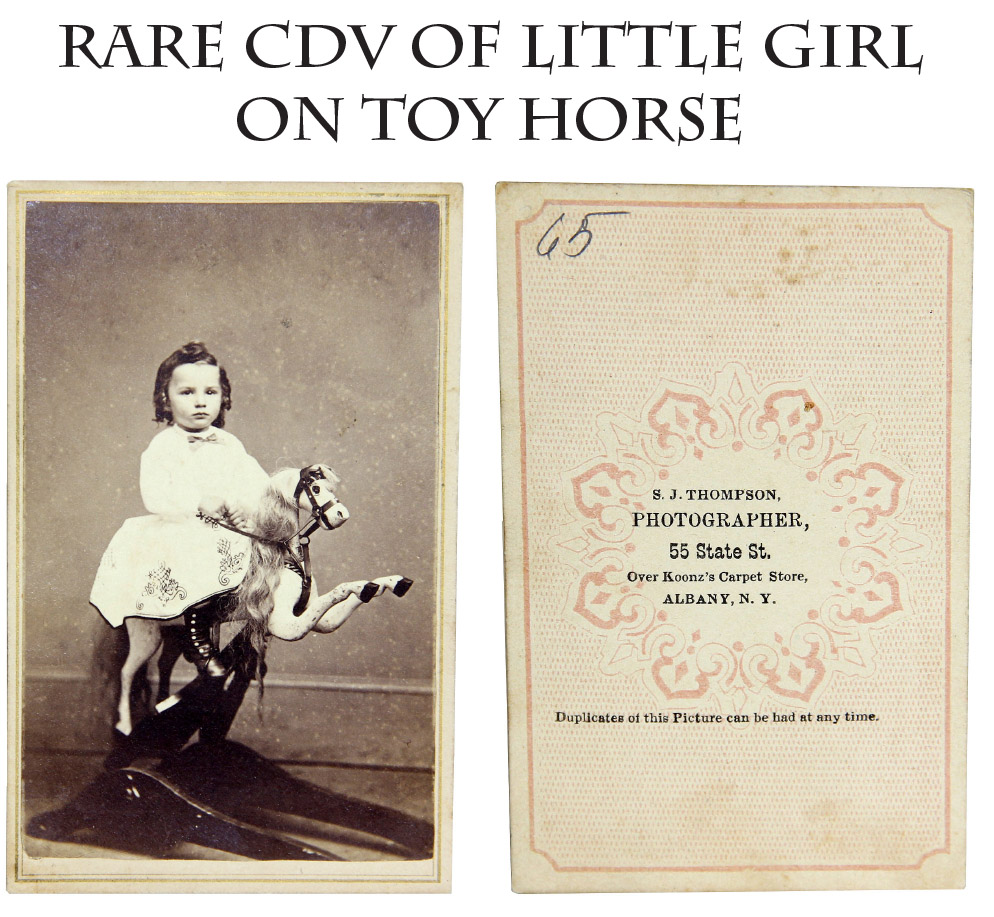
16-02-30 … Rare CDV of Little Girl (?) on a Toy Horse … S.J. Thompson, Albany, backmarked carte de visite format albumen of a young child on a toy rocking horse. Young boys and girls were often dressed and coiffed alike during the period, but this seems to be a young girl posed on her favorite toy. Wonderful clarity and a great pose with the child looking a little serious, as if she really had to keep the rearing mount under control. Also, a bit of a telling reminder of how important it was to parents to preserve an image of their children in the days of high infant mortality. A very sentimental portrait. Excellent in all respects … Didn’t sell at $135, so we’ll mark it down for Christmas … fe … $95.00 – SOLD
Call us @ 419-842-1863

16-02-31 … Interesting CDV of “Fisherman at Work” … Photos of people smiling during this period are very unusual. Portraiture by photography was regarded by many as a formal presentation of oneself to the world with no room for frivolity. This fellow, however, was happy in his work: “The ‘Fisherman’ at work, fishing on land. Stringing a big “fish” for the college,” according to the printed caption pasted on the reverse. This cheerful bearded fellow sits a marble top table with inkwell close to the camera and pen in hand, apparently writing a letter on a portable writing desk he has set out on the table. Fitting the printed caption is a portrait of a fish on the lid of his writing box, that he displays for the camera. The allusion to being “a fisher of men” seems pretty clear and the reference to a college then implies a religious institution, though “stringing a big ‘fish’ for the college,” may refer to securing a donor for a school or something of that sort. If he is, indeed, an educator it might be possible to identify him. The printed caption suggests there are more images of him out there. There is a good story here in any case and it’s an intriguing and entertaining photo … Didn’t sell at $135, so we’ll mark it down for Christmas … ee … $95.00
Call us @ 419-842-1863
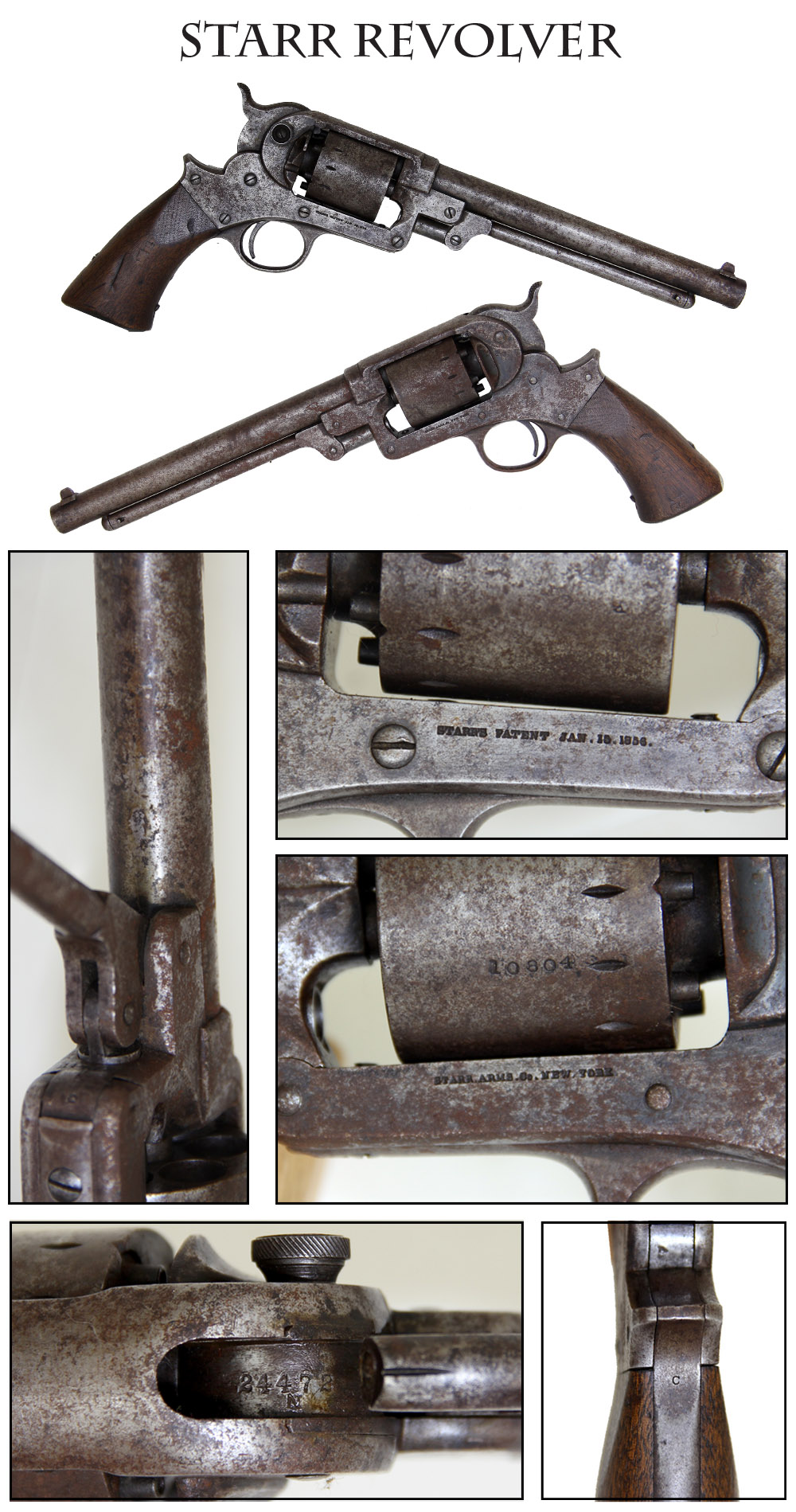
16-02-34 … SINGLE ACTION STARR ARMY REVOLVER … The Starr double actions were too far ahead of their time- at the very least the trigger pull would throw off any chance of hitting your target. The single action was more conventional and replaced it mid-war. This one was obviously “ridden hard and put away wet,” showing gray underneath a generous surface dusting of brown. Much of this would clean easily, but of course most of the bluing is long gone. Still, the markings are crisp and the wood, though it has some dings, still has a tight fit and shows a visible cartouche. The cylinder shows serial number 10804 and the loading assembly 24472, so the gun was plainly issued and the assembly switched over a campfire cleaning. I see mixed numbers on these stars about 35% of the time. Overall a solid “gun metal grey” gun … h-1/2-szym … $1,195.00
Call us @ 419-842-1863
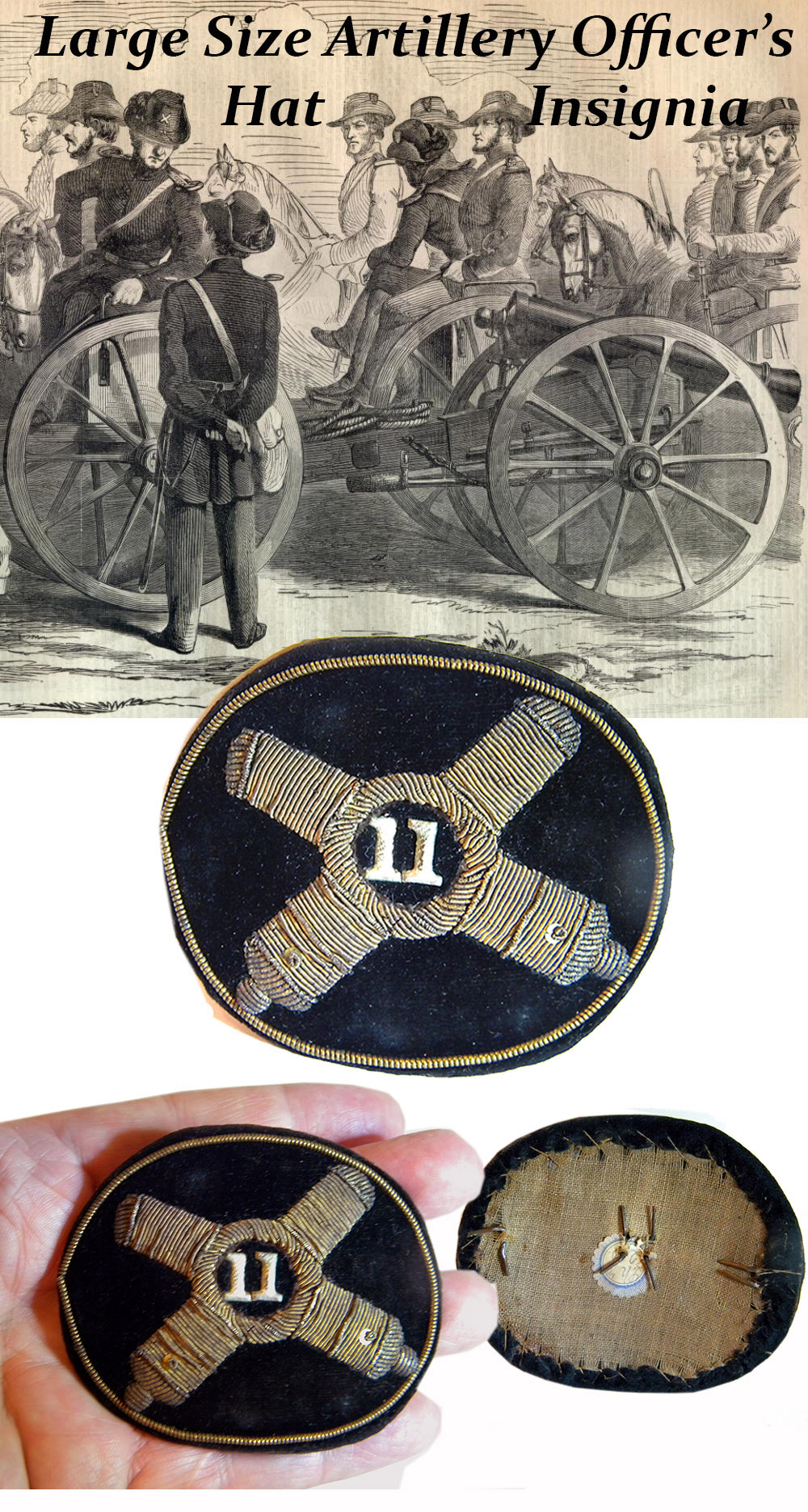
16-02-35 … MAGNIFICENT GOLD EMBROIDERED ARTILLERY OFFICER’S CROSSED CANNON HAT INSIGNIA … All Civil War embroidered hat insignia is scarce. Cavalry is much scarcer than infantry. Artillery is much scarcer than cavalry. This piece is top drawer in all respects. It is very large measuring over 3 inches across and 2 1/2 inches tall. The embroidery is executed on fine black velvet that has turned slightly brown with age. The wire edge border is intact. The velvet is sewn around an interior oval tin stiffener, and this stiffener is covered on the back with brown polished cotton. Inside the loop on the face are false embroidered stamped numerals 11. This could represent the 11th NY Artillery, the 11th US Colored Artillery, but more likely represents the 11th independent battery of “pick a state” as there were a lot more 11th independent batteries in the several states, than there were 11th regiments. Brass attaching wires are present on the back. Condition is extra fine … among the best available. One of the best pieces I’ve come up with in recent memory … $950.00
Call us @ 419-842-1863
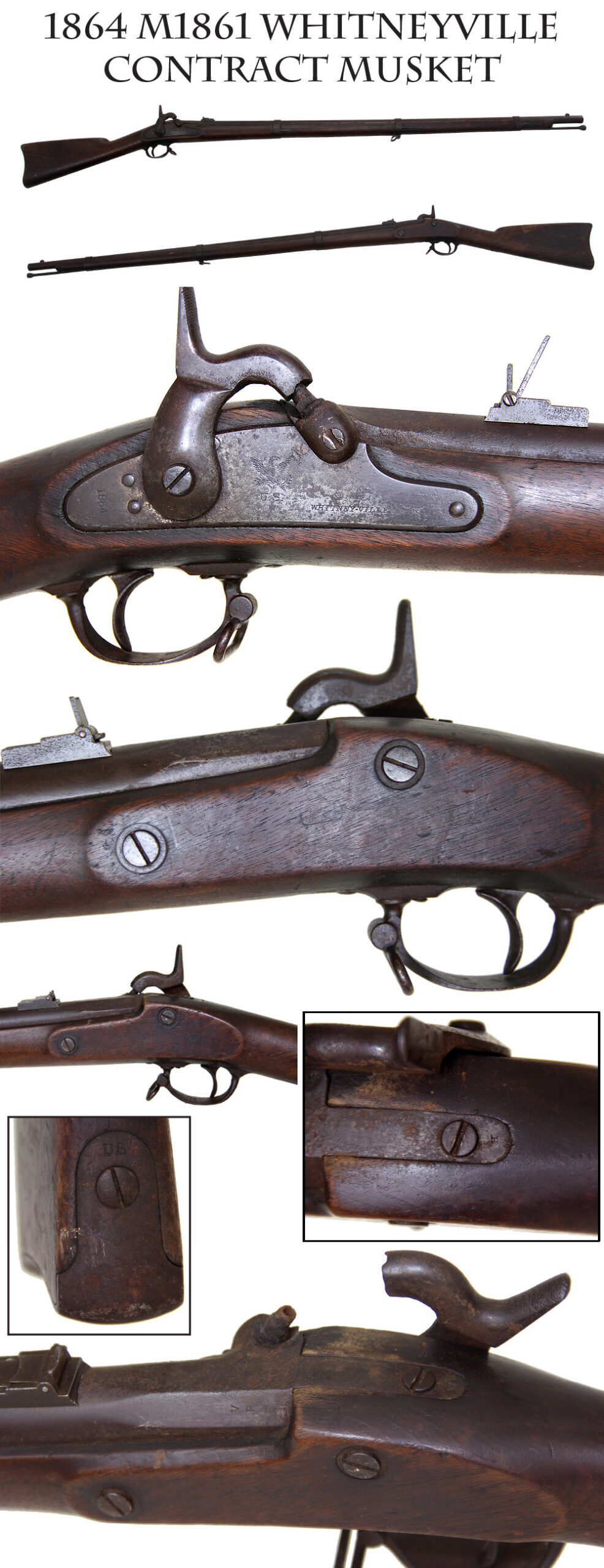
16-02-36 … Very Scarce Whitney Federal Contract M1861 Springfield Rifle Musket … An extremely scarce contract for the collector. Not as scarce as the New York contract listed above, but darn scarce. 1864-dated Model 1861 .58 caliber “Whitneyville Contract” percussion rifle-musket in VG to near fine condition. This musket was a product of Eli Whitney’s firm called the “Whitney-ville Armory”. All steel surfaces are attractive attic plum brown patina with strong markings, except the barrel date. The stock edges are sharp. No cleaning, no burnishing, no alterations…. overall strong “attic found” condition. Lock is marked with eagle over ‘U.S’ to the right of the hammer and the date “1864” behind the hammer. Under bolster is “WHITNEY-VILLE” in strong sharp stampings. Barrel proofs of VP & eagle’s head are sharp. The barrel date is obliterated by pitting at the breech. This great old musket is 100% original, 100% complete, and mechanically perfect. Rear sight is the proper early 1855-1861 style short range sight with the little “back porch” on it. Ramrod is straight style which is proper for this model. Bore has rifling but not sharp. Federal stock cartouche visible and legible on left side opposite the lock, between the two lock screws. Whitney was slow to fill his federal government contracts, except for the famed Plymouth Navy Rifles. He supplied Connecticut with 61 style muskets ahead of his federal contract. He initially agreed to manufacture 40,000 M1861 US Rifle-muskets for the Federal government early in the war. After he finished his Plymouth rifles, and his Connecticut contracts, he voided his first federal contract and signed one to supply 15,000 of these M-1861 muskets instead of the 40,000 he originally promised. He did so cleanly, and to federal specifications, in 1863 and 1864. This is one darn fine example of this scarce Federal Whitney ’61 Springfield … 40″ barrel … 56″ overall length. You can attend ten gun shows and will not likely see one of these contract muskets offered for sale … eej … $1,350.00
Call us @ 419-842-1863

16-02-37 … 1862 Dated Musket M-Rifle Enfield … Cal. 58. … 39 bbl. … Another very scarce US contract musket. This is a nice “as found” example of an 1862 dated “M” rifle as made by J.P. Moore & Sons in New York City early in the Civil War. These guns are fairly scarce and for many years were thought to be Confederate. When I began collecting as a kid, “common wisdom” dictated that these were absolutely CSA muskets. sThey appear in several texts as Confederate, some with North Carolina agent stamps in the stock. Current knowledge states they are unquestionably New York contract guns. Very scarce guns, but not Confederate. This musket is all original and complete, along with an Enfield bayonet in a New York contractor marked scabbard. Bayonet and gun metal are all dark and uncleaned and match very well. This gun conforms almost identically to the British Model P1853 Enfield rifle musket, having brass nosecap, trigger guard, buttplate and lock escutcheons. Balance of the gun is steel, including the Enfield style slotted ramrod. Gun overall is very good and sound, metal being dark with gentle surface pitting No discernible bbl markings, Lock marking of eagle holding a shield with “M” and 1862 date are well struck and easily discerned. Stock is sound and solid with numerous small storage dings and dents. There are a pair of initials “PR” carved opposite lock in stock. Accompanying bayonet matches gun perfectly. Blade is gray and smooth. Accompanying US regulation bayonet scabbard is sound and solid with areas of crazing and stitching is loose over half its length. Very scarce and very desirable … afjj-bjj-exhaa … Musket by itself … $1,675.00 … Musket with bayonet and scabbard … $1,925.00 – SOLD
Call us @ 419-842-1863

16-02-38 … World War 2 Combat Knife … Well worn but very appealing WW2 fighting knife. Has ordnance bomb stamped into the flat pommel cap. This is housed in a leather sheath which may or may not be an army issue sheath … I am sure you will know. I’m too lazy to research it. Neat item that was brought into my shop a couple weeks back … wlk-in … $75.00 – SOLD
Call us @ 419-842-1863

16-02-39 … INCREDIBLY EFFECTIVE LIGHTED MAGNIFYING GLASS / PERFECT FOR INSPECTING ANTIQUES …You have undoubtedly seen collectors at the shows running around with one of these magnifying glasses in their hand. There’s a good reason … they are SUPER! Months ago I bought one for myself and loved it. Then the local guys wanted one and I bought another half dozen for them at $25 each at the next show … Then I bought another one for me when I arrived at a show and discovered I’d left mine at home. I figured with as many as I was buying at retail, I might as well buy them in bulk and sell them at the shows and on the web page. These are absolutely essential for anyone buying antiques at shows or auctions. The intense illumination from the twelve LED light sources and 2x magnification exposes “artificial age” such as cold-blue on metal or amber shellac on wood. Shine this light and you will see if someone has “aged” or repaired the item you wish to buy. The magnification accompanied by the intense illumination reveals cracks and repairs that the naked eye cannot pick up. Requires 3 AA batteries (not included) … $25.00
Call us @ 419-842-1863
Layaways are Welcome
Need to split your order into multiple payments? No problem! A simple 20% earnest money deposit will hold your item for you.-acf
You can then pay it off in easy installments that fit your budget.
Read Terms Here
Items to Sell? Contact Us
I am always interested in buying ANYTHING from the American Civil War… Guns, Swords, Civil War Muskets, Knives, Uniforms, Flags, Medals, Badges, Diaries, Letters, Autographs, Buttons, photographs, tintypes, daguerreotypes, Insignia, Camp Items, Battlefield Relics, canteens, Drums, Etc… Call 419-842-1863 and ask for Dave Taylor.

